San Francisco Bulls hold downtown press conference to formally announce new team for 2012-13 ECHL season
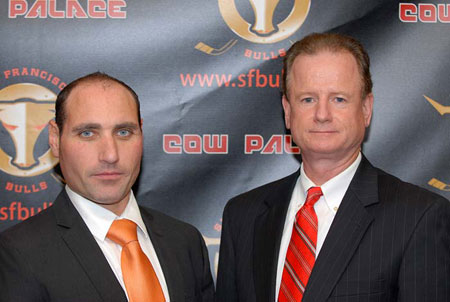
SAN FRANCISCO BULLS PRESIDENT PAT CURCIO, ECHL COMMISSIONER BRIAN MCKENNA

PAT CURCIO, BRIAN MCKENNA, DALY CITY MAYOR CAROL KLATT
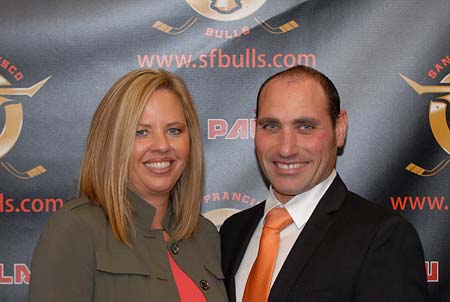
ELOUISE AND PAT CURCIO SPENT MONTHS OF GROUNDWORK PRIOR TO TEAM ANNOUNCEMENT
Two blocks from the historic Dragon Gate entrance to Chinatown, the San Francisco Bulls held a press conference Tuesday afternoon to formally announce their entry into the 2012-13 ECHL season. Bulls President/GM/Coach Pat Curcio was joined by ECHL Commissioner Brian McKenna, Cow Palace CEO Joe Barkett, Daly City mayor Carol Klatt and Maureen McEvoy of the SF Chamber of Commerce to welcome the team to the city and discuss the process they undertook to bring professional hockey back to San Francisco after a 15-year absence.
Curcio noted that earning an NHL affiliation and putting together an inaugural lineup is a priority, but right now his staff has to develop the business side of the franchise first. Gathering advertisers, sponsors, and selling season tickets needs to be at the forefront. “The players are going to be out there, the talent is going to be out there. We are going to put a product on the ice that is entertaining,” Curcio explained. “I think the key right now is to focus on the business, the hockey side is going to come.”
The former minor league forward and coach said that lessons could be learned from the last hockey tenant at the Cow Palace, the IHL San Francisco Spiders (preceeded by the San Jose Sharks, and San Francisco Shamrocks). “We were really fond of their attendance. They drew well, they had a following,” Curcio said of the Spiders. “I think when the old IHL became a rival to the NHL the numbers just didn’t work from a business perspective.” The IHL started moving teams to NHL markets, and looked to take advantage of the NHL lockout in 1994. When the NHL returned with a shortened season they started shifting away from the veteran league that featured higher salary players. “From our business model and our league level, (the SF Spiders) business model would make a very profitable franchise… We know a lot has changed over the last 15 years, but we believe it has changed for the better.”
The San Francisco Bulls were officially welcomed to the city by SF Chamber of Commerce member Maureen McEvoy and Daly City mayor (and St. Louis Blues fan) Carol Klatt. After three recent Allstar Games in California (Fresno, Stockton and Ontario), ECHL Commissioner Brian McKenna said that the ECHL would love to bring the minor league showcase to the city by the Bay, but that the team needed to establish itself on the ice first.
Discussing a prominent trend of recent seasons, McKenna said NHL teams will continue developing top goaltending prospects in the ECHL. “It is one of the areas we have had success,” McKenna said. “The theory with most NHL teams is rather than having two young goaltenders playing in the American League and splitting the games, splitting the ice time, they would much rather have one guy in our league and one guy in the AHL where they are each getting 50-60 games of action.” The ability to play game in and game out and survive the professional grind also negates somewhat the shock younger junior and college players feel when moving up to the more rigorous professional level. “In our league, because it is an offensive wide open style of league, they are going to get lots of shots, lots of experience, and probably develop a little quicker.” McKenna and Pat Curcio pointed to Olaf Kolzig, Byron Dafoe and the Stanley Cup winning Tim Thomas as examples of goaltenders who played in the ECHL and then moved up through the system. Recent California examples include Jaroslav Halak in Long Beach, Devan Dubnyk in Stockton.
While the Cow Palace will be one of the larger venues on the ECHL landscape, the location of the press conference also pointed to one of the issues the team will have to overcome. Without being in San Francisco proper like the San Francisco Giants, and without a significant legacy fan base like the 49’ers, the Bulls will have to work hard to get a sizeable group of families and casual fans to make the short 20 minute hop down to Daly City. Marketing and heavy involvement in community and athletic groups in San Francisco should make that job easier. San Francisco is a city that sells itself, absorbing as much of that as possible can only help the Bulls. Blogger and San Francisco resident Marylisa Walsh does not believe that will be a problem.”They will come,” she said.
Pat Curcio said one of his primary points of motivation for his future players will be the NHL franchise 45 minutes down the penninsula. “It is an hour away, but it is a long road.” Curcio lingered heavily on the invisible middle syllable in long. “It’s a long road, but it starts here.”
Season tickets are on sale now from $650-1,440 per seat and will require a $50 deposit. The first 1,000 people to purchase season tickets will receive an inaugural San Francisco Bulls black t-shirt, and will receive preferred seating in their section. A photo gallery from the press conference is available here.
[Update] Partial press conference transcript:
ECHL Commissioner Brian McKenna:
I know that Pat Curcio, his wife Elouise and his entire management and ownership team have done a lot of work over the last several months, basically the better part of a year to make this day possible. From the league’s point of view, we are very excited about it. A little about the ECHL, we are entering our 24th season of play this upcoming season, which will get under way in a couple of weeks. We will operate this season with 20 teams. San Francisco will become our 21st team next year, and our 9th team in the Western Conference. We currently have 8 in the West and 12 in the East.
Over 460 players who started in our league have gone on to play in the National Hockey League. We are clearly a development league. We are the ‘AA’ league of hockey in the professional ranks. About half of our players on an annual basis will move up and play in the American Hockey League. Half of the coaches in the AHL, the ‘AAA’ hockey league, are former ECHL coaches. 7 of the 21 head coaches in the National Hockey League today, roughly 25%, are former ECHL coaches as well. The level and caliber of play is improving every year, and we are proud of that.
Why San Francisco? First and foremost we have a willing ownership group here that did a lot of research, checked out a number of markets in the East and West. Finally after about 6-9 months of searching, they settled on San Francisco. We really believe in the market, and they have an iconic facility in the Cow Palace that I am sure is excited to have hockey back as a permanent tenant. We have a base of hockey fans in the area, we know that. The Sharks played here for two years, certainly to full houses in the early 90’s, and there was an IHL team here in the mid-90’s as well.
From a league perspective, it is a good geographic fit for our teams in the Western Conference particularly those in California. We currently have teams in Stockton, Bakersfield and Ontario. What can the fans expect? A great entertainment product at a very affordable price. Most of our players are 1-3 year pros who are working on their craft, trying to develop and move up. Certainly you will see an entertaining and hard working group of athlete’s on the ice. Most of our fans our casual fans, mom’s and dad’s who want to take their kids to a family to a fun entertainment event. We believe the Cow Palace presents a great venue. We are sure the great team will put a great hockey operation on the ice and surround it with great promotional and entertainment ideas to make it a fun and affordable entertainment experience for families in the area.
The league routinely draws over 3 million fans per year, so we are certainly in the forefront as an entertainment option in North America. We are very much looking forward to the fall of 2012 when we can come to opening night here in Daly City and welcome the Bulls to the ECHL.
San Francisco Bulls President/GM/Coach Pat Curcio:
Thank you all for coming. It has been quite a journey to this point, it has been very exciting. There have been a lot of sleepless nights. A little bit about my background, I grew up as a hockey player. I played the better part of 12 seasons in the minors and in Europe. I learned the hard way to keep a keen eye on the business, even as a player I was always fascinated by, and always dreamed of owning my own team. I have had a few attempts over the years after I stopped playing in 2001. I have been coaching for the last 10 years. I have been in the management part of the game for the better part of 10 years, so this has been a dream come true for me. I couldn’t be sitting here without my wife (Elouise). She is the brains behind the operation.
A couple of years ago, we have made contact with Brian (McKenna) over the years. We have tried to get a couple of other franchises. We really wanted to be on the West Coast. We found that San Francisco is just the perfect market. We feel that there are a lot of people from the East that have moved here over the last 5-10 years. There hasn’t been pro hockey in San Francisco in 15 years. We believe we will be able to provide affordable entertainment for the families of San Francisco. Also providing secondary corporate opportunities for other companies that couldn’t spend big money for major league sports. We believe there is all of that and more here. We want to get out the grassroots, teach kids how to play hockey. We want to be part of the community, and part of all the little communities not only in Daly City and San Francisco, but everything in the surrounding areas as well. We really feel we can be a part of all that.
People ask me all the time, why San Francisco, why the Cow Palace. It is a funny story, we came to San Francisco. We looked and said how can this place not have a hockey team. I stuck my wife onto the whole project and she did a lot of research. She actually has some work here and she was here quite often. She kind of fell upon the Cow Palace and it works there. We talked to Joe (Barkett). Joe was a major player in this whole thing. Without Joe, we wouldn’t be sitting here today. He invited us out to an event at the Cow Palace. We went to see Cirque du Soleil and were sold. This could be hockey. This has a hockey feel, and it is an old barn. It is our barn now, and we are real excited.
We think what the San Jose Sharks have done here, and now living in San Jose, they have done a tremendous job in the industry for hockey, just building the game. Their attendance is close to 18,000 a night. I don’t know how many people travel from San Francisco, but when we talk to people it is a very difficult commute, especially at 7 o’clock at night. People are very excited to have hockey within a 10 mile radius, especially in our price range.
It is also awesome for the city. Someone told me the other day that we complete the city. That was nice to here. In January when football is over, we will be the only professional sports team in San Francisco playing until April, which is the majority part of our season. We are real excited about offering that to San Francisco, Daly City and the other local communities. I can’t tell you how excited I am to be a part of (the ECHL). I coached in the league, played in the league. I can tell you numerous players are now in the National Hockey League. They have a number of fingerprints on that league, and they have done that for years now. These are young, hungry players that compete every night to try to make it.
We have to do some work on the Cow Palace, which we are excited to do. We plan to put new scoreboards, we plan to have new videotrons,
we plan to do some upgrading in the dressing rooms. They have already done lots of work in the concourse and the concessions. The place is great right now. We plan to upgrade the ice system, hopefully with our upgrades the Cow Palace will be able to attract some other event, things like Sesame on Ice and things like that, which have been here in the past.Season tickets will go on sale right away. We hope to push to get people involved right off the bat. We have some great promotions. We are giving t-shirts away to the first 1000. The first 500 get a ticket to the rodeo. We are going to do things with pick a seat, and preferred seat, preferred parking deals for our season ticket holders. Now is the time to contact us and get involved.
Cow Palace CEO Joe Barkett:
We have been working together several months. We are very, very excited to have what we consider now to be our anchor tenant at the Cow Palace. It is going to, as Pat alluded to, help us continue the progress we have made the last couple of years, to bring more and more good family entertainment to the Cow Palace for the people in our community, San Francisco and San Mateo counties.
I want to say to anyone concerned, we are looking forward to a 36 game season. All the events that you enjoy at the Cow Palace now, from the dog show, to the rodeo, to the concerts, they will all still be going on at the Cow Palace. Thankfully we have really good cooperative discussions to make sure that can happen. The only difference is, in a couple weeks if you come out to the Grand National, you will see a rodeo out there. A year from now when you come out to the Grand National, you will see a rodeo taking place over the ice. You won’t know it, but it will be under there. That is true of a number of events that will be going on.
We are very, very pleased. We are going to make some terrific improvements to help us continue to grow. We are very, very enthusiastic partners we feel for the longterm with the San Francisco Bulls, for the benefit of San Francisco and San Mateo counties.
[Update2] Northern California gets a third hockey team, San Francisco Bulls will make ECHL Pacific Division debut in 2012 – Sharkspage.
San Jose Sharks have a lengthy travel schedule for 2011-12, but they lose NHL’s Frequent Flyer title to the Los Angeles Kings by a wide margin
2011-12 NHL TEAM TRAVEL SCHEDULE:
(miles to travel, back-to-back-games, 1 game road trips)1. Los Angeles Kings – 55,591, 15, 13
2. Florida Panthers – 52,751, 14, 8
3. Anaheim Ducks – 50,296, 13, 10
4. Edmonton Oilers – 50,006, 12, 10
5. Dallas Stars – 49,622, 14, 17
6. Phoenix Coyotes – 49,192, 13, 15
7. Calgary Flames – 49,104, 10, 5
8. Colorado Avalanche – 48,945, 10, 18
9. Vancouver Canucks – 46,826, 11, 2
10. Winnipeg/Atlanta – 44,627, 14, 8
11. San Jose Sharks – 43,994, 14, 5
12. Tampa Bay Lightning – 43,717, 10, 12
13. Detroit Red Wings – 42,865, 14, 20
14. Minnesota Wild – 42,860, 11, 12
15. Columbus Blue Jackets – 42,831, 16, 17
16. Nashville Predators – 39,534, 11, 10
17. Chicago Blackhawks – 39,288, 17, 20
18. Montreal Canadiens – 39,174, 13, 19
19. St. Louis Blues – 38,781, 17, 20
20. Carolina Hurricanes – 38,114, 16, 24
21. Washington Capitals – 37,969, 13, 22
22. New York Rangers – 36,385, 14, 11
23. Buffalo Sabres – 35,911, 21, 23
24. Philadelphia Flyers – 34,193, 13, 20
25. Ottawa Senators – 33,915, 17, 20
26. Boston Bruins – 33,770, 13, 11
27. Pittsburgh Penguins – 33,439, 15, 17
28. New York Islanders – 32,410, 13, 20
29. Toronto Maple Leafs – 32,239, 17, 21
30. New Jersey Devils – 28,597, 15, 24Source: Dirk Hoag, ontheforecheck.com
Without stepping onto the ice for the regular season the San Jose Sharks have already lost their #1 ranking in one area of the game. For two of the last three seasons, San Jose has lead the league in travel (56,254 miles in 2010-11, 56,111 miles in 2008-09). In 2009-10 the Sharks finished a respectable 8th in miles traveled (46,415), but that figure comes with a caveat. Five San Jose regulars played up until the final night of the two week 2010 Winter Olympic break in February. What followed was a condensed stretch run that saw 20 games played in the final month and a half. It pushed the team to slightly better than a game every other day schedule. Not a pace condusive to the start of the grueling 4-round Stanley Cup Playoffs.
The Sharks began 2010-11 with high hopes and high miles. After being out in front of the league drafting German prospects for several years, San Jose played a lively exhibition game against Deutsche Eishockey Liga’s Adler Mannheim then traveled north for back-to-back NHL Premiere Games against the Columbus Blue Jackets at the Ericsson Globe Arena in Stockholm, Sweden. At the time, a 7-day break between European and North American regular season games was considered advantageous. That theory was proven incorrect on the ice. A pair of home opening losses to Atlanta and Carolina were a wake-up call. Up-and-down play continued until it was capped by a near franchise worst 6-game losing streak in early January.
“We have to make sure we’re pushing probably earlier this year than we did last year. We let them off the hook a little bit too much,” Sharks head coach Todd McLellan said of the poor start last year. “We have to hold them accountable.” Making that slightly easier will be 12,260 fewer miles to fly than last season.
Travel at the NHL level is far different than the normal commercial experience. San Jose’s new chartered 747 has it’s own youtube videos, and very well may have it’s own facebook page and twitter feed. For professional athletes, time spent in the air is often time spent not sleeping, but the dangers of ritual travel became all too apparent with the crash of Lokomotiv Yaroslavl’s charter flight that killed Sharks prospect Daniil Sobchenko and 8 other former NHL’ers. Many hockey players and team staff are uncomfortable flying, but they have to hop on dozens of flights regardless.
On the West Coast travel is de rigueur. Pacific Division teams have fewer 1-game roadtrips than the Eastern Conference, San Jose is tied for the second fewest this season with 5, more back-to-back games (14), and more stretches of 3-games-in-4-night play. Chartering a bus for a road game is out of the question. The newly relocated Winnipeg Jets franchise, Canada’s only Southeast Division team, will surprisingly log only 44,627 miles this year. “I don’t mind it. It’s not that big a thing,” Winnipeg defenseman Mark Stuart told the National Post of the expected travel. “There’s really no excuses. It’s not like what Vancouver or L.A. or those West Coast teams have to go through. That’s tough out there.”
According to On the Forecheck’s Dirk Hoag, fellow Pacific Division rival Los Angeles will take over the 2011-12 title for most difficult travel schedule with 55,591 miles to fly but the Rangers will be busy early. New York will begin a grueling 5 cities in 4 countries exhibition schedule shortly (Prague, GothenBurg, Bratislava, Zug) before starting the path to the Winter Classic. Anaheim will play an exhibition game against Jokerit in Finland before debuting the season in Helsinki as part of the NHL Premiere against Buffalo. Los Angeles will have an exhibition against Hamburg in Germany before playing the Rangers in Stockholm.
Eventually the Winnipeg Jets franchise may have to be moved out of the SouthEast, a decision which the league could begin to discuss in December. Detroit and Columbus have expressed a desire to move to the Eastern Conference, Dallas would like to move out of the West Coast heavy Pacific Division. With 6 divisional games a year against San Jose, Anaheim, Los Angeles and Phoenix, a considerable number of Stars road games are not even in the same time zone. It may be time to take the training wheels off of Vancouver, place them in a much more difficult Pacific Division, and let the other pieces land where they fall.
Tommy Wingels scored twice, Sharks hold on for penalty filled 4-3 preseason win over Vancouver Canucks
The Sharks returned to the scene of last year’s playoff exit, but there remained a considerable amount of tension bubbling just under the surface for an average preseason game. Right wing Tommy Wingels continued his solid exhibition season for San Jose with 2 goals. One on a nice off the wall feed by Joe Pavelski in the first period, the other after Cam MacIntyre and Jamie McGinn squeezed a defenseman behind the net and a puck popped out in front of the crease for a quick Wingels shot. Keeping the stick on the ice and sliding to an open area was a theme Sunday night. Andrew Desjardins labeled a shot high far side after another backhand feed off the wall by John McCarthy. Veteran winger Brad Winchester opened the scoring for San Jose, posting up at the side of the net and punching home a loose puck on the fourth whack. Alexander Sulzer, Cody Hodgson and Nolan Baumgartner (PP) scored for Vancouver. Thomas Greiss stopped 26 of 29 shots against. The 4-3 win helped San Jose tie Nashville for the high water mark in preseason with one fewer game played.
Sunday night facing a prospect heavy lineup, the Sharks were pushed on the scoreboard and on the ice. Several Canucks prospects tried to make an impression on 6-foot-3, 245-pound defenseman Douglas Murray. Battling for a position on Vancouver’s fourth line, forward Aaron Volpatti lined up Murray for a hit along the corner in the first period. Later in the game a Murray shoulder fake froze Volpatti as he tried to line up another hit. The move caused Volpatti to lose his balance and attempt an awkward back-first check. He ended up colliding into the boards and skating off the ice gingerly. Steve Pinizzotto, a minor leaguer also loooking for a spot on the fourth line, telegraphed a hit against Murray and ended up on the wrong side of the force = mass times acceleration equation. Pinizzotto did not return to the game for the second period. Defenseman Aaron Rome also suffered a broken hand for Vancouver and did not return for the third.
The bubble over occured halfway through the second period. Murray stepped up and stepped through Maxim Lapierre at the top of the offensive zone. As Lapierre is wont to do, he made a b-line straight for a smaller player, in this case Murray’s defensive partner Dan Boyle. As Murray came over to pull Lapierre off Boyle, Antoine Roussel dropped the gloves with him and ended up on the receiving end of 10 heavy punches. Lapierre took a knee while fighting Boyle, but the Sharks defenseman continued to land 5 blows despite a pair of linesman trying to pull them apart. Lapierre and Boyle received 2 minutes each for roughing, Murray and Roussel 5 minutes each for fighting. Lapierre earned an extra 2 minutes for cross-checking that was served by 2011 Danish draft pick Nicklas Jensen. Apparently Lapierre’s stint as a role model on the ice was a short one.
The battle for a shrinking number of roster spots has picked up for San Jose with only 2 preseason contests remaining against Vancouver at home on Thursday, and on the road at Phoenix on Saturday. If veterans Brad Winchester (tryout) and Andrew Murray are penciled in on the fourth line with Andrew Desjardins, as many as 5 players could be battling for one spot on the third line. All except former Princeton winger Cam MacIntyre have have NHL experience that could in part color the roster decision: Jamie McGinn (143GP), Benn Ferriero (57GP), Brandon Mashinter (13GP), and Tommy Wingels (5GP). Brad Winchester (323GP), Andrew Murray (181GP), and Ben Guite (175GP) also bring considerable NHL experience. The Sharks coaching staff are somewhat dealing with known quantities. Looking at the third and fourth line depth of the 2010-11 Vancouver Canucks, 2009-10 Chicago Blackhawks, and 2006-07 Detroit Red Wings, 3 of the last 5 teams to knock San Jose out of the postseason, the decision not to bring in a tested third line scoring winger is a organizational one. The Sharks are tied for first in the NHL for the average number of in-house drafted and developed players on the roster since 2005-06 (12).
Head coach Todd McLellan got to see a situational focus on penalty killing with 11 minor penalties, 1 fighting major, and two 5-on-3’s Sunday night. Andrew Murray and Benn Ferriero lead all forwards with 6:37 and 5:49 shorthanded time on ice respectively. Jamie McGinn (4:31) and Tommy Wingels (3:34) also picked up considerable shorthanded minutes. Defenseman Douglas Murray and Brent Burns also paired up on the penalty kill. Brad Winchester scored the opening goal for San Jose in the first, and created a nice give and go for Andrew Desjardins at the side of the net in the second, but he took a few questionable penalties late in the game. An uneccessary elbow up high was his first minor, but he took a boarding penalty in the second and a roughing penalty after running former Shark Niko Dimitrakos in the third. Knowing when to play physical, when to take liberties, and when to stay out of the box was a significant problem for the Sharks fourth line last year in the regular season and in the playoffs. Douglas Murray also took one of the more obvious penalties of the night, losing an assignment in the slot and racing across the ice to bear hug a forward at the same time Thornton took a roughing call.
With Desjardins in the box 9 seconds into the third period for roughing, Benn Ferriero made a pair of excellent plays shorthanded on subsequent PK shifts. On the first he made a diving clear at the top of the zone, and on the second he made a play that created a turnover and lead to another clear. After having two injured players leave the game, Nolan Baumgartner took a puck off the knee and hobbled off the ice. He would return and later score on a 5-on-3 point shot. The Canucks began their 7th power play late in the third with only 4 shots on goal with the man advantage. With Winchester in the box, Burns took a boarding call leading to 1:07 of a 5-on-3. Desjardins, Murray and Vandermeer were the PK unit on the ice. After Baumgartner scored, San Jose still had to kill 1:25 of Burns’ penalty when Wingels high sticked Hodgson. With 4 seconds left on a 5-on-3, the Sharks lost a critical d-zone faceoff and the Canucks quickly maneuvered the puck on net. Ebbett tipped a shot through traffic wide. Pulling goaltender Lack with one minute left, Douglas Murray and Brent Burns combined for late clears to ice San Jose’s fourth straight preseason win.
Former Sharks Owen Nolan and Niko Dimitrakos were released by the Vancouver Canucks Sunday night. Also put on waivers by the St. Louis Blues was former Shark Jonathan Cheechoo. The San Jose Sharks released four players to the AHL Worcester Sharks Monday afternoon, including goaltenders Thomas Heemskerk and Tyson Sexsmith, defenseman Nick Petrecki, and forward Brandon Mashinter.
[Update] Owen Nolan: Cut by Canucks, considerable class act – Yahoo’s Puck Daddy.
[Update2] Vancouver Canucks head coach Alain Vigneault questioned the legitimacy of Douglas Murray’s hit on Rome in a post-game press conference Sunday night:
I think for players now, I look at tonight’s game and there is going to be an adaptation period on what referees are going to call and what they are not going to call in the interpretation.
I look at Murray’s hit on Lapierre tonight. If that is not exactly what Aaron Rome did last year, it is. It is probably .2 .3 seconds later than what Romer did on Norton. There is adaptation period that everyone is going through from the new guy in charge of discipline, to the referees on what they have been told on the ice.
It is going to be very interesting to see how everybody adapts from the players, to the referees, to the coaches cause it is a real fine line right now.
Irregardless of the fact that Murray’s hit came less than two seconds (total) after Lapierre’s pass, nowhere near Aaron Rome’s situation despite Vigneault’s statement, it was not even the most questionable late hit of the game. Maxim Lapierre hit Tommy Wingels high in the third period while he was 10 feet off the puck. Murray’s hit on Lapierre didn’t draw a penalty. Lapierre’s drew an interference call. It was a clear admonition from the referees, and reluctantly acknowledged by the Canadian announcers. The questions heading into the 2011-12 are not only about hits to the head and how players are going to adjust to the new Rule 48 guidelines, but how officials can better stamp down on dives and attempts to manufacture penalties, of which Vancouver was one of the more egregious offenders. Complaints from fans and media of one playoff opponent can be written off as sour grapes. When each opponent at every step of a Stanley Cup Final run complains of heavily exaggerated dives, it needs to be addressed by the league. This isn’t European soccer.
[Update3] The Hockey News puck panel of Edward Fraser, Ryan Kennedy and Rory Boylen evaluated the 2011-12 Vancouver Canucks on Sunday, Anaheim Ducks today.
[Update4] Was Alain Vigneault right to play the Nathan Horton card? – Yahoo Puck Daddy.
[Correction] Added note of both remaining preseason games, Vancouver @Sharks on Thursday, Sharks @Phoenix on Saturday.
Dallas Stars at Colorado Avalanche photo, plus a mini-Avs preview
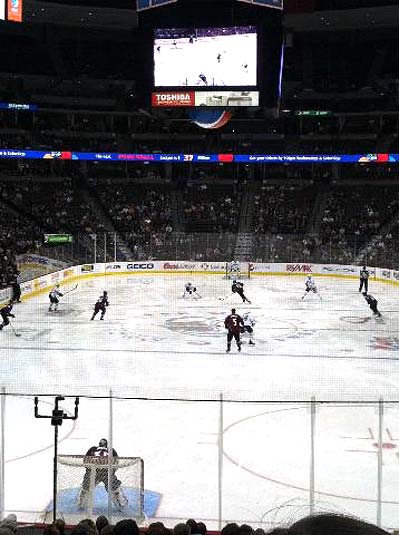
COLORADO EARNED A 3-0 PRESEASON WIN OVER DALLAS - PHOTO MIKE SASSON
My brother Mike sent in a photo of the Avalanche’s 3-0 preseason win over the Dallas Stars Sunday night at the Pepsi Center in Denver. Ryan Stoa (PP), and Ryan O’Reilly (2) accounted for all 3 goals for the home team as newly acquired goaltender Jean-Sebastien Giguere recorded a 16-save shutout. Giguere joins former Washington Capital goaltender Semyon Varlamov in net for Colorado after last year’s tandem of Peter Budaj and Brian Elliott were not brought back. Elliot was a somewhat shock addition in a March 2011 trade for highly regarded netminder Craig Anderson. Anderson struggled out of the gates to a 13-17-3 start, but it was a 7-game losing streak that ushered him out of town less than a year after a career 38-win regular season and strong WCQF postseason showing against San Jose. Colorado Avalanche GM Greg Sherman may have overreached trading a 2012 first round draft pick and a conditional 2012 or 2013 second round draft pick to Washington for Varlamov, but locking down reliable goaltending had to be a priority for the start of a rebuilding effort/youth movement.
Several teams in the West took hits, Bryzgalov leaving Phoenix and Brad Richards leaving Dallas were two of the most notable, but the 2010-11 playoff race began in earnest post-All Star Game. If there is a repeat over the second half of 2011-12, there may be too many hurdles for a young Colorado squad to overcome. Adding 6-foot-4, 237-pound defenseman Jan Hejda and ill tempered 6-3, 230-pound Shane O’Brien to 6-foot-4, 232-pound Eric Johnson will greatly improve the stability of the defense in front of Giguere and Varlamov. Scoring will still be at a premium even with the return of Peter Mueller. The Avs will scratch and claw for playoff position, but they may be a year or two out from returning to the mix. The Hockey News 2011 Annual somewhat disagrees, picking Colorado to finish a surprise 9th in the Western Conference, 2nd in the Northwest Division. Stanley Cup odds were listed at 50-1, but with several question marks up front, that may be optimistic.
San Jose sees Colorado for the first time November 20th in Denver, and at home December 15th at HP Pavilion.
Finnish goaltender Harri Sateri posts 28-save shutout, Benn Ferriero notches game winner as roster battle intensifies
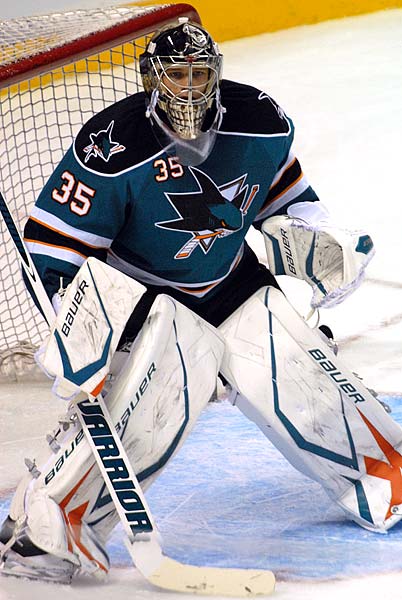
FINNISH GOALTENDER #35 HARRI SATERI STOPPED 28 SHOTS FOR SHUTOUT OVER PHOENIX
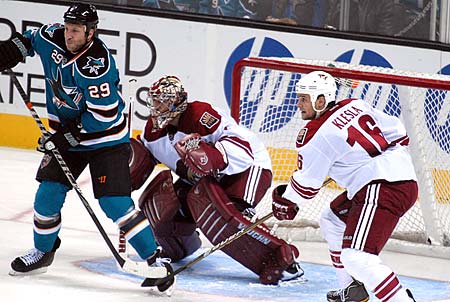
NET FRONT PRESENCE WAS A THEME SATURDAY, CLOWE DEFLECTED PUCK ON NET IN 2ND
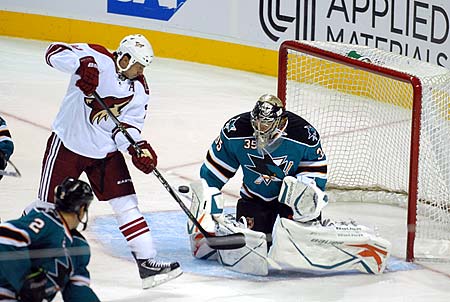
SATERI STOPPED 1 OF ONLY 3 PHOENIX SHOTS ON GOAL IN THE SECOND PERIOD, SJ EARNED 3RD STRAIGHT PRESEASON WIN
The Sharks are in a different place as an organization from when they had a trio of starting goaltenders vying for one starting job. Evgeni Nabokov, Miikka Kiprusoff and Vesa Toskala have moved on to different teams, but there may be another three headed goaltender battle developing if German netminder Thomas Greiss can impress in a back-up role while Antero Niittymaki navigates a three month recovery from surgery. Greiss is going to get the bulk of the preseason workload, but starting goaltender Antti Niemi has recently started taking shots in practice after his minor offseason surgery. He could be ready to go at or near the start of the season according to Sharks head coach Todd McLellan.
The Sharks top AHL development affiliate in Worcester has similar injury adjustments it needs to make for the start of the season. Goaltender Alex Stalock recently skated for the first time since February surgery to repair a severed nerve in his knee. It was reported by the Duluth News Tribune this offseason that his doctors recommended a full year off from on-ice training. That could effectively end or significantly shorten his 2011-12 season. An unorthodox goaltender who battles hard to make saves in net, Stalock lead the entire AHL with 39 wins in 2009-10. Stalock is not just a prospect working his way up through the organization, he is seen a future candidate for the starting role. Forefront in the Sharks mind on both NHL and AHL tracks was an incident in 2005 when Nabokov and Toskala tried to return too soon from injuries. They both pushed the envelope on their recovery, and both aggravated respective shoulder and groin issues. Time will be taken with injury recovery, but as evidenced on Friday and Saturday night there is still a lot of talent left in the Goaltending Factory.
21-year old Finn Harri Sateri put on a preseason goaltending clinic against Phoenix Saturday night in his debut at HP Pavilion. He stopped all 28 shots he faced, despite 6 Coyotes power plays and several scrambles in front of his own net. Highly regarded as one of, if not the top European goaltender available in the 2008 draft, Sateri dropped into the 4th round and was picked up by San Jose Sharks Director of Scouting Tim Burke. The Sharks traded a 7th round pick in 2008, and a 4th round pick in 2009 to move up to get him. He was the second European goaltender selected after Jacob Markstrom. On the draft floor, Sateri told TSN speed and skating were two of the biggest strengths of his game.
Saturday the Sharks had a different mix of regular players and prospects than they did the night before against Anaheim. With a roster split half and half, San Jose was pushed by the Coyotes early. “I was a little nervous at the beginning of the game,” Sateri said. “I gave a couple bad rebounds, but then I had a couple great saves and relaxed, and I just enjoyed it.” The flow of the game slowed considerably in the first. There were 4 total penalties in the final 10 minutes, and 6 in the second period alone. Lines and d-pairs from both teams had trouble getting into a rhythm. Sateri’s biggest test came late in the first after a rebound created a pileup in front of the goalmouth with several players jostling for position. The 6-foot-1, 210-pound Sateri kept his body in front of the puck, and was forced to make several quick reaction saves on short shots. Given more time to set and face shooters, Sateri showed a compact style, with an economy of motion. Antti Niemi is in a class of his own when it comes to speed getting down into the butterfly, but Sateri gets down to the ice quick while still in a controlled fashion.
In the third period Phoenix tried to carry the puck behind the net and set up forwards cutting through the slot. Sateri was solid sealing off the post, and square to the shooter when the puck came out in front. It was a deliberate and focused style of play that normally comes from a more experienced goalie, but the exuberance came through after the preseason win. “It’s a great feeling, a win, a shutout, in my first exhibition, a great feeling,” Sateri said. ‘I just tried to play my own game.” Injuries are a fact of the modern game, but at the very least Sateri will start his first full professional season in North America as the #1 goaltender in Worcester.
The second preseason game in as many nights was also an opportunity to evaluate several ongoing roster battles for third and fourth line roles. With Havlat still on the mend, Tommy Wingels joined Logan Couture and Ryane Clowe on the top line and the trio created the first scoring chance for San Jose. A point shot by Jason Demers was tipped just wide with traffic in front. The game devolved into fits and starts, penalties and several odd-man rushes. Both teams tried to adjust and maintain clean possession. A big part of settling down the San Jose side late in the first period was newly acquired defenseman Colin White. Bought out in the offseason by New Jersey, White signed a 1-year, $1M deal with San Jose and has somewhat flown under the radar. Known for his size (6-foot-4, 215-pounds) and hard edge defensive ability, there is more nuance to his game than some on the West Coast may be aware of.
“San Jose has been great. The weather’s been great. Obviously, the team’s been working really hard this past week, and it shows in the games,” Colin White said after the win over Phoenix. White and veteran defenseman Jim Vandermeer add a leadership and toughness quotient to the Sharks defense. White has a pair of Stanley Cups with New Jersey (2000, 2003), served stints as alternate captain, and has playoff experience in 10 of his 11 years in the league. Several times on Saturday night White was communicating with d-partner Jason Demers on the ice, then later on the bench. While departed defenseman Niclas Wallin was tough in front of his own net, his assets may have been best suited more for an Eastern Conference style of play. Colin White is known as a solid defensive defenseman, but as more games pass on the calender he may grow into a slightly different role for San Jose.
“I think we play defense first, but it leads to the quickness up the ice. We take care of our own end and try to spend short periods of time in it, obviously,” White said after the game. “Defense is still priority on this team, like any other team. But, they want me to jump up in the play a little more, which is new and exciting. It will take a little getting used to, but I like it so far.” In the third period Colin White neutralized a Phoenix scoring chance deep in the defensive zone. He held off a forecheck, protected the puck with his body, and allowed the forward line to get a head of steam going before he slid a pass up the wall. Repeat that a few hundred times over the course of an 82-game season, and it could be one of the more underrated moves made this offseason.
Torrey Mitchell and John McCarthy flashed speed, but could not convert on first period breakaways. Cam MacIntyre dropped the gloves with left wing Kyle Chipchura for an extended fight in the second period, then started the third period with a heavy wrist shot that narrowly sailed over the top of the net. Left wing Taylor Pyatt somehow irrated Ryane Clowe down low, and was cross checked high twice while on the ice as a result. Clowe gave him a long look before skating back to his bench. Phoenix goaltender Jason Labarbera wants to make an impression after the departure of Ilya Bryzgalov to Philadelphia. Labarbera was run into by the foot of Wingels in a third period race for icing. He performed a half tiger roll to draw the penalty. Labarbera stopped 29 of 30 shots, but could not get any offensive support from his team. The Sharks turned up the heat at the end of the third. Handzus narrowly missed a breakaway opportunity on his backhand, and a hesitation move by Couture resulted in a quick Clowe-Wingels connection that was smothered by Labarbera. Brandon Mashinter sidestepped two players to create a scoring chance, and drew a late penalty that eventually resulted in the game winner.
Benn Ferriero capitalized on the power play, chopping home a rebound as bodies, limbs and snow all converged around Labarbera at the same time. Ferriero did a mini-Bobby Orr dive to the side of the net, and was joined by his teammates for a quick celebration. Ferriero noted how last year’s playoff experience helped him as a player. “[Playing in the playoffs last year] definitely helped,” Ferriero said. “Obviously playoffs is ramped up another notch. It definitely helped to get a couple games under my belt, and it benefitted me going into this year.” 16,221 was the announced attendance for Saturday’s preseason game.
Sharks look crisp, polished in 5-1 preseason stomping of Anaheim Friday night at HP Pavilion
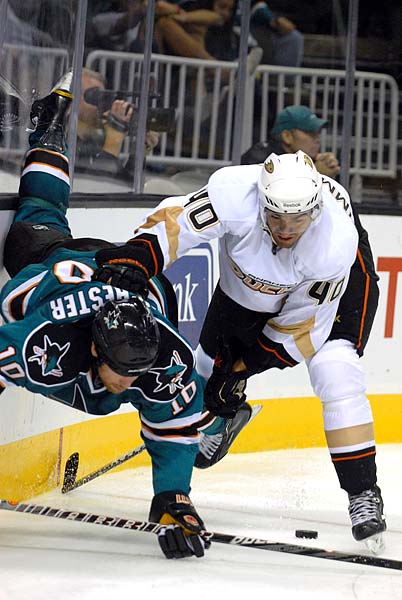
ANAHEIM D #40 ZIMMERMAN CHOPS LEGS OUT FROM UNDER LW #10 BRAD WINCHESTER IN 3RD
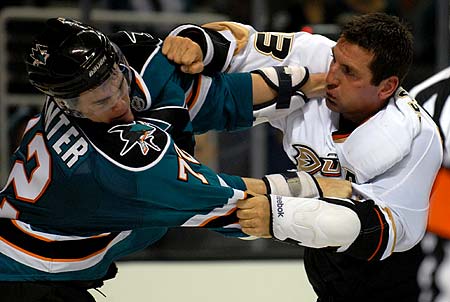
#72 BRANDON MASHINTER THROWS WITH #23 FRANCOIS BEAUCHEMIN AFTER BIG MASH HIT
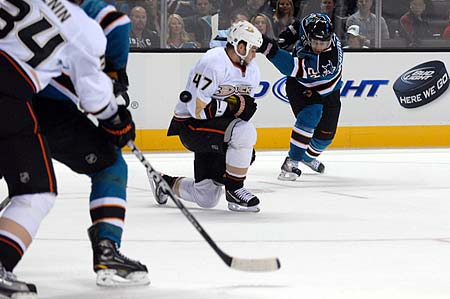
RW #28 ANDREW MURRAY FINISHED WITH 1G, 4SOG, AND 15:07 TOI
The San Jose Sharks earned their second heavily lopsided preseason victory over the Anaheim Ducks in three nights, this time pulling out a 5-1 win with goals by 5 different players. Matt Irwin (PP), Dan Boyle, Douglas Murray, Torrey Mitchell (PP) and Andrew Murray (PP) scored for San Jose and goaltender Thomas Greiss stopped 13 of 14 shots against. Ryan Getzlaf scored the lone power play goal for Anaheim in the second period with help from a leaping Corey Perry screen in front.
If preseason games can be seen as a tool for teams to prepare for the regular season, they also can reflect on the state of a team’s preperation up to a point. Early in the first period it was clear the San Jose Sharks were the crisper, more energetic side. Passes were on the tape, players were moving well off the puck and getting up and down the ice. The battle for open positions on the Sharks side is intense, with several players taking every opportunity to make an impression in front the coaching staff and fans. Anaheim may treat the development aspect of preseason differently. In the second they were assessed a bench minor penalty for failing to take the ice in time to be ready for the start of the period. Last year the Ducks were outshot in every preseason game but 1 (190-163), losing 4 of 6 in the process. This year that trend has intensified with 3 straight losses and a 114-64 margin. In two back-to-back contests against the Sharks they have given up a combined 11 goals and 77 shots.
“It’s a preseason game and I think we have to take a look at the positives,” Sharks defenseman Dan Boyle said. “We did a lot of good things right, but they had a quarter of their lineup out there.”
A surprisingly strong 16,541 near sellout crowd was very vocal to kick off the preseason at HP Pavilion. While they were able to see right wing Andrew Murray and defenseman Matt Irwin score their first goals as Sharks, and defenseman Brent Burns register his first point in the second period, the focus shifted more to the play of Thomas Greiss in net and the competitive play of the Sharks prospective third and fourth lines. Greiss, who should see the bulk of starts in preseason with Niemi on a short term recovery track from minor surgery and Niittymaki several months out, was in regular season form in net. Positionally, he was aggressive and crisp. Breaking up several oncoming chances with his stick, Greiss also covered the lower portion of his net well with traffic collapsing around him. On Wednesday night, a fluke deflection off the defense caught Greiss moving the wrong direction to keep him from registering a shutout against the Ducks. On home ice Friday it was the leaping screen of Corey Perry that set up Ryan Getzlaf for a power play goal. Anaheim split duty between Dan Ellis for two periods and Jeff Deslauriers for the third. Ellis gave up 4 goals on 36 shots against, Deslauriers 1 goal on 13 shots.
During the Teal and White scrimmage, and both preseason games against Anaheim, veteran winger Brad Winchester has made an impression in front of the net. On a preseason fourth line with Andrew Desjardins and Andrew Murray, Winchester was a net front presence at every opportunity in his own zone. The 6-foot-5, 230-pound frame was an issue for both Ducks goaltenders, and he was very difficult to move from out front by the Anaheim defense. One of the players battling Winchester for the opportunity to play is hulking 6-foot-4, 235-pound Brandon Mashinter. Mashinter started the second with an impressive shift, slowly curling around the Ducks net and battling a pair of players to get off a wraparound shot. Keeping his feet moving to corral the rebound, he chopped the legs out from a Ducks player sans penalty. Later in the second defenseman Mathieu Carle tried to slow down Mashinter with a hit along the boards, but he ended up in a heap on the ice. After crunching veteran defenseman Francois Beauchemin with a big hit along the end boards in the third, Mashinter got into an extended fight that saw both players bloodied. While the topic of fighting in hockey is a controversial one at the moment, the dangers of getting hurt by an irresponsible play on the ice are very real. Scoring goals and keeping opponents honest are two of Mashinter’s strengths. Brad Winchester ragdolled Mark Bell in another fight near the end of the third period.
On a third line with McGinn, Handzus and Mitchell, it was McGinn and Mitchell slashing through the offensive zone early in the first. A hip check by Peter Holland narrowly prevented a clean Torrey Mitchell breakaway on goal. McGinn has speed, offensive instincts, and as evidenced by the playoffs last year, he can make an impact with physical play, but in order to stick with the NHL roster for the full 82 game season he will need production. He has impressed averaging over half a season the last three years, but his best year in 2009-10 saw him register only 13 points. Last year he scored a goal and 5 assists in 49 appearances. McGinn will not only need to put numbers on the board, but he will have to give the Sharks staff confidence he can add production in the playoffs as well or EVP/GM Doug Wilson may keep an eye on trade deadline options.
A late first period penalty saw a huge momentum swing for the San Jose Sharks which never subsided. The top power play unit of Marleau-Thornton-Pavelski had the puck on a string and Anaheim chasing the play. Defenseman Brent Burns registered the play of the night with a blind, spinning keep-in at the point. A Duck beat him to the loose puck at his feet, but he dove to the ice to prevent a clear. That directly resulted in two more scoring chances down low, and repeated oohh’s and aahh’s from the crowd after several near misses. “I think there should be some enthusiasm,” San Jose Sharks head coach Todd McLellan said after the game. “If you look at the two games, we had great leadership from the veterans. We played a fast, upbeat game and we saw some of the things we wanted to implement through training camp.”
Just using the on-ice play late in the game as an example, the blueprint for the third and fourth lines may have come into a little clearer focus. On successive shifts, Brad Winchester and Michal Handzus made a b-line to set up in front of the net after faceoff wins. A faceoff loss by Marleau prevented Thornton from driving the net from the wing on a third straight shift, something he did repeatedly earlier in the game. If Marleau and Havlat are going to key a speed/netfront offensive element on the top two lines, the third and fourth line may be geared to a more grinding, physical style. Whether that remains as the preseason and regular season progresses, and which players are in place to execute that gameplan, is a good question moving forward.
Newly acquired defenseman Brent Burns lined up a huge point shot in the second, allowing Handzus to easily direct the rebound to Torrey Mitchell at the side of the net for a goal. Earlier in the second period Burns tried to split the defense but was hit simultaneously by both. Keeping his feet moving, he skated around the traffic he created and checked defenseman Bryan Rodney as he played the puck behind his own net. Burns created a turnover, allowing a Sharks forward to create a scoring chance on the far side. “That was fun. It was a great experience; obviously it was a great experience to get the nerves out,” Burns said of his first preseason game in San Jose. “Coming out of the Shark head was a little scarier than I thought it would be. I couldn’t see anything for like 15 feet.” Not being boo’d was also listed as a bonus after the game by Burns. Quite the opposite, several overly exuberant fans were screaming his name in unison as they headed out to the parking lot after the game.
One more note on the updates inside HP Pavilion. According to VP of Business Operations Rich Soleto, the new clear glass system fits into a spring loaded channel inside the boards. In addition to the flex between panels, the result will be a much safer environment for hockey players in addition to the increased visibility for fans. It is different from the hardened, no-give seamless glass several teams used to use. Other changes are the pair of electronic ad panels in the boards, and the rounded glass at either end of the player benches. In addition to new menu items coming to concession stands, there are also a series of large 12-15 foot monitors hanging above the concourse. It is now possible to walk around the concouse without missing a play on the ice. There is no need to stop and watch a play as there is a screen every 50 or so feet.
A photo gallery from the game is available here. Video highlights from the preseason game are available here.
[Update] Tempest over a T-shirt: Sharks ban Bad Boys’ logo, triggering constitutional crisis – SJ Mercury News.
Northern California gets a third hockey team, San Francisco Bulls will make ECHL Pacific Division debut in 2012
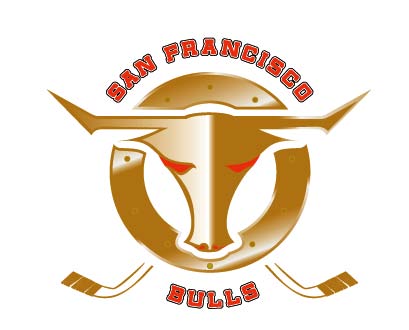
SAN FRANCISCO BULLS FRANCHISE APPROVED FOR 2012-13 ECHL SEASON ON WEDNESDAY
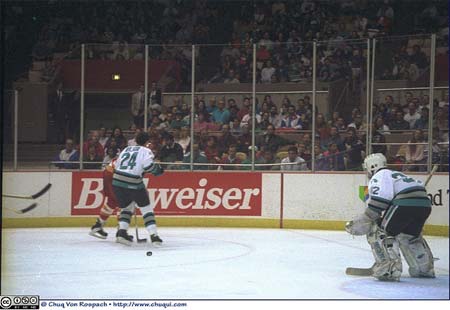
SJ CAPTAIN DOUG WILSON AND G ARTURS IRBE ON NHL ICE AT THE COW PALACE
News that Northern California will get a third professional hockey team for the 2012-13 season generated a lot of unexpected buzz around the hockey world this week. On Wednesday, the ECHL Board of Govenors approved a San Francisco Bulls franchise that will play alongside three other Californian teams (Stockton, Bakersfield, Ontario) and one from Nevada (Las Vegas) in the Pacific Division.
The process of bringing another hockey team back to San Francisco was a long one, but it was also “surreal and at the same time very exciting,” noted San Francisco Bulls President Pat Curcio. It was a 9-month journey from deciding on a hockey team in the Bay Area to meeting the state requirements needed to play at the Cow Palace. A state-run facility, there was not one person making the decision which resulted in more back and forth. “It was worth the effort, we are happy to be here,” Curcio told Sharkspage on Wednesday. “I think having a stable tenant here at the Cow Palace is something they have long waited for.”
Built in 1941, the Cow Palace (originally the California State Livestock Pavilion) has an illustrious sports and entertainment pedigree. It hosted the San Francisco/Oakland Warriors of the NBA three times, and served as the San Jose Sharks home for their inaugural two seasons while the then San Jose Arena was being constructed. The IHL San Francisco Spiders hockey team also operated from the Cow Palace in 1995-96. Curcio notes that with an upgraded ice system, and upgraded scoreboard and facilities, the Cow Palace will be “a fun place to watch hockey.”
With no expansion or supplemental draft in the ECHL according to Director of Communications Joe Babik, the San Francisco Bulls will look to add veteran free agents from around the league as well as dip into the junior, major junior and college ranks. “We want to be an exciting team. Youthful, energetic and offensive,” Curcio said. “An entertaining team. A team that even if they are down 3-1 or 4-1 has the ability to score goals and come back.” The Bulls also hope to affiliate with an NHL team to help develop prospects. “Our goal is affiliate with a team like the San Jose Sharks when the time comes,” the Bulls coach/GM said. The Edmonton Oilers and San Jose Sharks renewed their co-affiliation with the Stockton Thunder last Tuesday.
A Toronto native, Curcio will serve as the team’s inaugural head coach and general manager. A veteran of close to 12 seasons in major junior and minor leagues in the U.S. and Europe, Curcio noted the inspiration instilled in him by legendary former Ottawa 67’s head coach Brian “Killer” Kilrea. It is a connection he shares with current Sharks EVP/GM Doug Wilson and Calder finalist Logan Couture. After his playing career finished in 2001, Curcio started on a coaching track that most recently saw him as an assistant coach with the London Knights of the OHL, the Utah Grizzlies of the ECHL, and back to the OHL with the Sault Ste. Marie Greyhounds. “While we were (in the OHL), we were still pursuing this dream,” Curcio said. “Here we are today.”
From a business perspective, minor league sports can be a hard road but it is difficult not to take into account the success minor league hockey has had in California. The debut of the Stockton Thunder at their new arena in 2005 could not have been more impressive for the central valley. Similar to San Jose, Stockton featured a hockey team as the centerpiece of their downtown revitalization efforts. The Thunder followed that with a sustained entertainment/sports push that resulted in the franchise leading the ECHL in attendance their first 4 seasons (averaging over 6,000 a game for 6). “You have to find ways to keep it interesting,” Stockton Thunder Director of Broadcasting and Media Relations Mike Benton told Sharkspage on Wednesday. While stressing the ability of the hockey staff to help develop hockey prospects, “we have found that found success is based on half selling the hockey and half selling the party,” Benton said. “There are fans that come to these games that have never seen a hockey game in their life.”
That is where minor league hockey in California diverges from the strict developmental structure on the East Coast and in Canada. “That’s what we have seemed to have done, not only to reach a hockey-centric fan base, but we have also become more of a lifestyle because we are appealing to people with different tastes and different backgrounds,” Benton said. Appealing to a broader audience not only has worked in Stockton, but also for the southern California Ontario Reign franchise which was founded in 2008. Ontario lead the league in attendance the last two years, with 240,596 and 232,223 fans at the gate respectively. Hosting the 2010 ECHL Allstar Game also drew more eyeballs to their new building, the Citizens Business Bank Arena. The Bakersfield Condors have finished a respectable 6th in attendance the last two seasons, but they have also finished second and first in playoff attendance which is a longstanding trend for their team. Even the defunct San Diego Gulls franchise folded due to ownership issues, not the lack of a strong fan base.
“We are so excited and proud to provide professional hockey to the San Francisco Bay Area,” Curcio told the San Francisco Examiner. It is an excitement shared by many. There will be a press conference at the Grand Hyatt hotel on Stockton Street in San Francisco (1PM, Fillmore AB room) September 27th to announce the new team. ECHL Commissioner Brian McKenna, representatives from the city of San Francisco and the Cow Palace will also attend. Season tickets go on sale October 3rd. Visit sfbulls.com for more information.
[Update] Press release from the ECHL:
ECHL Board of Governors approves Membership for San Francisco
September 21, 2011PRINCETON, N.J. – The ECHL announced on Wednesday that the Board of Governors has approved the Expansion Membership application of the San Francisco Bulls for admission to the ECHL.
San Francisco is scheduled to begin play in October 2012 when the Premier ‘AA’ Hockey League will celebrate its 25th season, making it the third-longest tenured professional hockey league behind only the National Hockey League and the American Hockey League.
The San Francisco ownership group is by Pat Curcio and his wife Elouise, who have relocated to San Francisco from Salt Lake City. Curcio will serve as president, general manager and head coach for the Bulls. The team will play its home games at the Cow Palace, located less than 10 miles from downtown San Francisco.
The Cow Palace opened in 1941 and has welcomed more than 50 million visitors through its doors. The arena, which has a capacity for hockey of approximately 11,000, was home to the San Jose Sharks during their first two seasons in the National Hockey League from 1991-93 and also was home to the San Francisco Spiders of the International Hockey League in 1995-96.
“San Francisco is a good addition to our Western Conference and a logical rival for our California teams in particular,” said ECHL Commissioner Brian McKenna. “We look forward to working with Pat as he assembles his front office team and works toward the October 2012 opening at the iconic Cow Palace.”
“We are so excited and proud to provide professional hockey to the San Francisco Bay area,” said Curcio. “The on-ice product will be very entertaining and the Cow Palace is the perfect venue for our team.”
“The Cow Palace is excited to host high quality, professional ice hockey again,” said Cow Palace CEO Joe Barkett. “It is an iconic venue that is well suited for an enjoyable and convenient fan experience. The San Francisco Bulls will offer great family entertainment for the San Francisco Bay area.”
DOH Podcast #169: Teal and White game, Brent Burns debut, new San Francisco Bulls ECHL franchise, Central division preview
Mike Peattie and Doug Santana review the Teal and White game from Tuesday night, discuss Brent Burns’ debut, take a look at the new San Francisco Bulls ECHL franchise, and preview the Central Division on the 169th episode of the Dudes on Hockey podcast.
This Sharks podcast is posted here with permission. Visit dudesonhockey.com for more coverage of the team or download the MP3 file directly here.
2011 Teal and White game showcases new Sharks under bright house lights, Team Teal brings the pain with 5-4 win
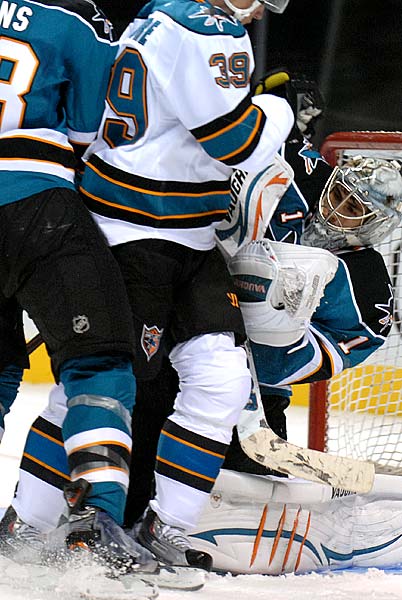
#1 THOMAS GREISS STOPS THE PUCK AS #39 COUTURE CRASHES THE NET
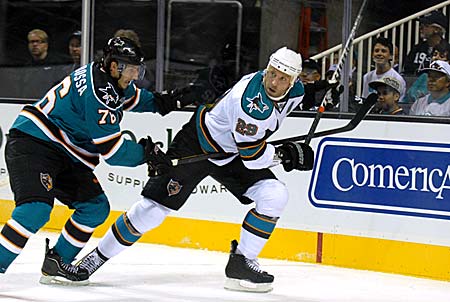
#29 RYANE CLOWE GOES INTO CORNER VS #76 MICHAEL 'SCARBO' SGARBOSSA
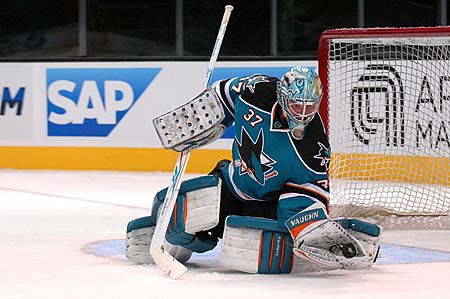
#37 TYSON SEXSMITH GLOVES A POINT SHOT IN 2ND HALF
The 7th annual Teal and White Game for San Jose Sharks season ticket holders was held on Tuesday night at HP Pavilion. It was an opportunity to see several new and prospective Sharks under the bright house lights. Fans traversed an overflow parking lot and the blast furnace heat of late summer San Jose to see Brent Burns, Michal Handzus, Colin White, Jim Vandermeer, Andrew Murray and others line up alongside and against last year’s Pacific Division champions. Martin Havlat, still recovering from offseason shoulder surgery, was not in the lineup.
One major offseason question has already been answered. ‘The Big Three’ this season will start with Joe Pavelski alongside Patrick Marleau and Joe Thornton. Pavelski adds another playmaking element to the top line and more consistent production, but he also has the net front style of a player 20 pounds above his weight. It is a scary prospect for the rest of the Western Conference to have Pavelski and Thornton looking to spring Patrick Marleau down the wing game in and game out. In the first it was a quick breakout pass by defenseman Brent Burns that launched Marleau down the ice on a breakaway. The Sharks got away from their speed game somewhat in 2010-11, but a big part of that was the lack of aggressive puck managment out of their own zone. Not only having Burns and Dan Boyle, but having them split on the top two defensive pairings will open up the Sharks offense considerably. In the first two minutes it was Thornton and Pavelski creating a defensive note with a strong forecheck. Thornton intercepted a breakout pass and wired a shot on goal, then ground in the corner with Pavelski to create a second turnover.
On Team White it was Logan Couture, Ryane Clowe and Benn Ferriero on the top line. Along with Havlat, Couture and Clowe could be considered a second ‘Big Three’. The chemistry Couture and Clowe maintained last season will be bolstered by the speed and creativity of Havlat, but it could take time for them to find a rythym. Couture scored 17 goals and registered 30 points in 40 games from Novemeber to January. He helped power the Sharks through their lowest point of the season which included a 6-game losing streak. The 22-year old Couture has also become one of the more consistent playoff scorers in two extended postseason runs. The adjustment period for Couture and Havlat could be little to non-existent to start the season. On Tuesday night’s scrimmage, Couture had the puck on his stick with his mouth wide open flying down the left wing to snap the first shot on goal.
A failed backhand clear by Team Teal’s defense lead to the first goal of the game by #56 right wing Brodie Reid. On the other side of the ice, defenseman Sena Acolatse labeled a hard slapshot high of the net. The Teal and White scrimmage was played for two 30-minute halves, with a half speed round of shootouts at the end. In goal for Team Teal was Thomas Greiss in the first, Tyson Sexsmith in the second. Harri Sateri played the first for Team White, Thomas Heemskerk in goal for the second. Griess played his way up through the Sharks organization to back up Evgeni Nabokov, but was loaned to Byrnas of the Swedish Elite League last year after the additions of Antero Niittymaki and Antti Niemi. With Niemi recovering from a short term injury, and Niittymaki a little futhur out with a lower body injury, Griess could be given a large workload in the interim. Solid technically with a large frame, confidence and compete level were two issues Greiss needed to improve on in order to maximize his potential. Tracking the puck through traffic was a concern for Greiss early, but he improved as the period progressed. Harri Sateri also looked very good in goal for Team White. Whether Sateri can push Greiss in the preseason to back up Niemi will be an interesting battle to monitor going forward.
After a massive collision between 5-foot-11, 170-pound left wing Michael Sgarbossa and 6-foot-3, 220-pound Brandon Mashinter, Team White was forced to kill off their predetermined 5-minute penalty. In the scrimmage, each team would have to kill off a 5 minute power play, White in the first, Teal in the second. A slashing penalty on Colin White that dropped a forward in the corner to give Team Teal a 2-minute 5-on-3. Joe Thornton slid the puck into Patrick Marleau on the doorstep. Marleau was sandwiched between two defenseman, but neither checked him off the puck. Marleau corraled the puck on his stick, then slid it back to Thornton who kept his stick on the ice. Thornton one-timed the pass back on net to score the first goal of the game for Team Teal. Offensive defenseman Justin Braun would help set up the second. Braun has a natural, quick release from the point and offensive instincts that make him a tantalizing prospect for the future. A quick Braun shot deflected off of the new endboards directly to Joe Pavelski in the slot. Pavelski buried it. Game tied 2-2.
Patrick Marleau completed the top line trifecta with a power play goal to start the second half, but Teal failed to convert on a solid breakaway opportunity and a net front Michal Handzus deflected a shot past Tyson Sexsmith. Torrey Mitchell and Colin White were credited with assists. On the other side of the ice, Thomas Heemskerk deflected a flicked shot on goal into the corner, but trying to clear the puck up ice Douglas Murray banked it off the back of the goaltender’s pads and into his own net. Thornton celebrated a little too much on the own goal, directly in front of Murray. 4-3 Teal after being down by two goals to start the game. Jamie McGinn joins Handzus and Mitchell to start the 5 minute power play in the second for Team White. After being checked hard twice in the allegedly non-checking scrimmage, Jason Demers hammers a hard, low shot on goal. Jamie McGinn, still moving, slid to the center of the slot and deflected it far side by Sexsmith. 4-4.
There seemed to be a Teal-wide effort to target Douglas Murray. After Burns and Vandermeer boxed out forwards for Sexsmith to make a save, Brent Burns bear hugged Murray and tugged at his jersey. Vandermeer and the referee were both laughing as Murray skated away. Murray was laughing too. After impressing at last year’s rookie tournament and training camp, and at this year’s rookie tournament and training camp, left wing Michael Sgarbossa dotted his t’s and crossed his i’s with the game winning goal with 43.7 seconds left. A hard backhand to forehand move saw him beat Heemskerk with a highlight reel play. Team Teal won the regulation portion of the scrimmage 5-4. Sgarbossa also scored in the shootout with quick wrist shot for Teal. Marleau, Clowe, Couture and Pavelski also scored in the SO.
The Teal and White game is a great opportunity to see the players and lines prior to the start of the preseason, but it was also an opportunity for fans to meet fellow season ticket holders, and interact with players for autographs and photos after the game. There were several booths for younger fans including face painting, balloons, photo portraits and caricatures, and an on-ice skate post-scrimmage skate. There were also several upgrades to the facilities, the details of which were not readily available. There was new glass and boards from Sport System Corp. The glass elements are larger, clearer and still have some flex. Instead of the silver sheath stanchion that slid between the old glass, the new partions are grey and white which should make for better visibility live and on broadcast. The boards are also different as evidenced by the Braun caromb that resulted in Pavelski’s goal. There may be a number of shots off the end boards in preseason as the Sharks try to fine tune the bounces. There was also word of new seats and electronic advertising, but keep an ear out for confirmation on that.
A photo gallery from the scrimmage is available here.
The Hockey News Radio Show/Podcast: 2011-12 NHL season preview, Western Conference, Eastern Conference, LA Kings
Last Friday on The Hockey News Radio Show, co-hosts Adam Proteau and Scott Laughlin set up the NHL season-preview show. In the opening block, THN associate senior writer Ryan Kennedy breaks down the Western Conference, In the second block, senior writer Ken Campbell does the same for the teams in the East. In the final segment, the Ask Adam mailbag deals with questions on Andrei Markov, the L.A. Kings, NHL fan clubs and more.
This podcast is posted here with permission. Visit thehockeynews.com. For for more NHL coverage. Download the podcast via Itunes, or directly via the MP3 file here.
Sobering offseason for San Jose Sharks organization tests a tight-knit hockey community
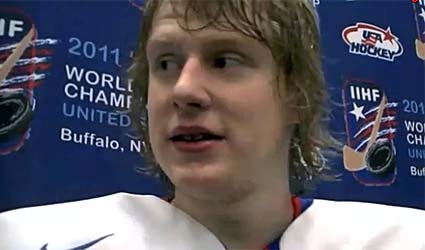
SHARKS 2011 DRAFT PICK DANIIL SOBCHENKO DIED IN SEPTEMBER LOKOMOTIV YAROSLAVL PLANE CRASH
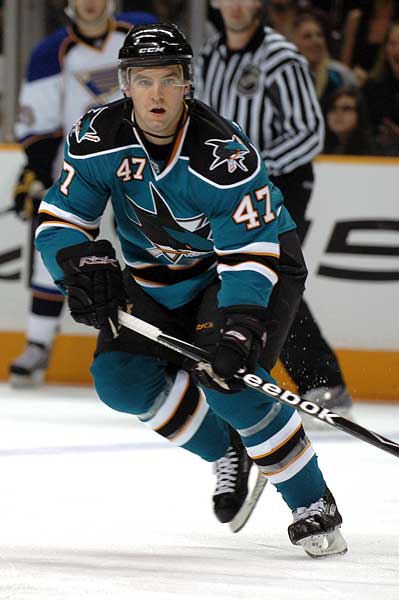
FORMER SAN JOSE/WORCESTER SHARK TOM CAVANAGH PASSED AWAY IN JANUARY
It has been an offseason full of tragedy for the game of hockey. The San Jose Sharks organization was not spared. The deaths of three current and former NHL players who embraced the physical side of the game stunned the league, players and fans. Popular Minnesota Wild forward Derek Boogaard, a 6-foot-7 enforcer many considered the heavyweight champion of the league, died due to an accidental overdose in May. In August, Rick Rypien and former Maple Leaf/Predator Wade Belak may have taken their own lives under differing circumstances. Added to the unspeakable toll was the January death of well liked 28-year old Worcester Sharks forward Tom Cavanagh, whose long struggle with mental illness was not widely known. His death was also believed to be a suicide.
Several of Cavanagh’s teammates in Worcester and San Jose were unaware of his medical problems. After playing 4 years at Harvard, 4 years for the Sharks AHL affiliates in Cleveland and Worcester (Cavanagh is still the Worcester Sharks franchise leader in assists and points), and 18 games over two seasons in San Jose (where he briefly played on a line with Joe Thornton and Jeremy Roenick), his father Joseph Cavanagh told the Providence Journal-Bulletin that Tom’s “private struggle far surpassed his public athletic accomplishments.” In the stoic business of the National Hockey League, a young player known for his intelligence and work ethic tried to overcome his problems on his own. It is a theme that may carry over with the deaths of Boogaard, Rypien and Belak. The league needs to get to a place where it not only encourages players to ask for help, but convinces them that asking for help is not a weakness.
It is not clear how much, or if, it was a contributing factor in any of the deaths, but the debilitating effect of lingering head injuries and post-concussion symptoms was a problem the league was forced to address. After Sidney Crosby was knocked out for the season with back-to-back hits to the head by David Steckel and Victor Hedman in successive games, and Marc Savard was knocked out of Boston’s Stanley Cup Championship season with his second concussion in 10 months, the NHL and NHLPA took action in-season to introduce new concussion protocols. It required players who sustained head injuries to be removed from the ice and evaluated by medical personel. The protocols may be adjusted slightly this season, but the goal is to reduce damage that may impact players for a lifetime. The CBC ran a series of features on the issue of concussions and the NHL: evaluating a new helmet microchip that can offer an objective statistical model for hits to the head, detailed Patrice Bergeron and Willie Mitchell’s long road back from concussion injuries, and noted that advanced concussion testing has begun for many youth hockey players. Sidney Crosby was cleared for non-contract drills at the start of the Pittsburgh Penguins training camp. Logan Couture and defenseman Brent Burns are a pair of cornerstone players in the Sharks organization that have overcome concussion problems in the past.
There is no set schedule to mourn, but returning to one of the most difficult sports in the world is a measure of respect on it’s own. The turn of skates on fresh ice at training camp is another step in the healing process. That process was dealt a significant blow on September 7th. As the Kontinental Hockey League opened it’s 2011-12 hockey season (it’s fourth with teams in Russia, Kazakhstan, Belarus, Latvia and for the first time, Slovakia), a Yak-42 plane crashed on takeoff killing nearly the entire Lokomotiv Yaroslavl team and staff. 43 passangers and crew died immediately, and left wing Alexander Galimov died several days later due to extensive burns. It was one of the worst tragedies in hockey’s over 100 year history.
“This is the darkest day in the history of our sport,” IIHF President Rene Fasel said of the crash. In a statement released by the team, San Jose EVP/GM Doug Wilson noted that 2011 6th round Sharks draft pick Daniil Sobchenko was amonth those on the plane. “Daniil attended our development camp this past July and everyone on our staff agreed that he had a bright future with our organization,” Wilson said. “He was an amazing person with a fun-loving personality and his attitude and energy during his time in San Jose was infectious. Our deepest sympathies go out to his family and friends.”
The 3-time Russian champion Lokomotiv (1997, 2002, 2003) was a strong KHL side, winning it’s division and finishing 3rd overall in the 2010-11 season. They lost in Conference Finals to Atlant Moscow. As Atlant Moscow and Salavat Yulaev met in the season opener for a Gagarin Cup Final rematch, KHL president Alexander Medvedev stopped play in the first period and relayed the news to a stunned crowd. The high powered offensive team featured 8 former NHL players on their roster and coaching staff including Pavol Demitra, head coach Brad McCrimmon, Ruslan Salei, Josef Vasicek, Karlis Skrastins, Karel Rachunek, Alexander Karpovtsev, Igor Korolev in addition to Swedish national goaltender Stefan Liv. Lokomotiv cancelled their participation in the 2011-12 KHL season, and instead will field a VHL team in the second division Russian Major League. Puck World’s Bruce Peter has more on the outpouring of support for Lokomotiv around the KHL.
The 20-year old Sobchenko was a promising young center with size and playmaking ability. While playing with Lokomotiv, Sobchenko missed considerable time during the season participating in top level international competition for Team Russia. He was a member on the top line of Team Russia’s gold medal winning World Junior Championship team, one that engineered a miraculous 5-goal comeback for a gold medal against favored Canada. He also centered promising young wingers Maxim Kitsyn and Vladimir Tarasenko and the 2010 Subway Series. Profiles of Sobchenko on FinzandStitches and Hockeys Future painted a picture of a promising offensive hockey prospect. After attending a rookie camp in San Jose, Sobchenko noted that the NHL was superior to the KHL. He was excited about his future prospects in both, hopeful despite a wealth of offensive Russian talent that he could make a 2014 Olympic team in his home country.
Several local reports described the Bay Area hockey community’s response to the tragedy. Comprised of several disparate elements, they all congeal around the San Jose Sharks at the top of the food chain. Rookie tournaments, training camp and preseason are an opportunity for the hockey community to kick into gear and get excited about the upcoming season. At a USA Hockey Women’s/Girls hockey tournament several years back in San Jose, hundreds of parents traveled a significant distance to be at the tournament with several thousand young female hockey players. In the stands, questions about the Eastern Conference or individual players could be bounced off of the parents, or more focused questions about college teams or youth leagues. There was an affection and friendliness among the parents. It is not hard to see a supporitive environment in the Bay Area mirrored in pockets around the U.S. and Canada. Most of the hockey community in San Jose did not get to meet Daniil Sobchenko or see him play, but thoughts and prayers for his family are surely directed to his relatives in the Ukraine and Russia.
While the NHL is trying to address problems facing it’s players, the KHL is left to address more sructural problems concerning it’s league. It has been an ambitious if slightly rocky first four seasons for the global league, but it’s growth may have come at a cost. After the death of New York Rangers prospect Alexei Cherepanov in 2010 brought to light the need for standard medical support and equipment to be available league-wide, the plane crash that killed the entire Lokomotiv Yaroslavl team also raised significant questions. As BBC America host Katty Kay noted the day after the tragedy, “It is 20 years after the fall of the Soviet Union, and the problem remains that plane crashes in Russia are not a surprise.” NBC Sports’ reporter Yonatan Pomrenze noted that Russia has more aviation deaths this season than any other country in the world. It is not just the daredevil Illyushin-76 Russian cargo pilots making dramatic deliveries into Africa and Afghanistan (as covered in ‘Phantom Air’, Men’s Journal September 2011), it is major league hockey teams, governments and other major business entities cutting costs by flying questionable air carriers and questionable planes. There is no doubting the talent and sophistication of many Russian pilots and aircraft, but an adequate level of professionalism is not standardized accross the country. Current Russian President Dmitry Medvedev said that the recent wave of plane accidents in Russia must stop, even if they have to use foreign aircraft.
As the puck drops for the start of San Jose Sharks training camp, one of the darkest summer’s in the sports history overshadows a normally ebullient time.
DOH Podcast #168: Training camp discussion, Brad Winchester tryout, injuries, Atlantic division preview
Mike Peattie and Doug Santana preview the start of Sharks training camp, discuss the tryout offer to veteran forward Brad Winchester and Winnipeg’s addition of former Shark Kyle Wellwood, weigh options for San Jose’s third and fourth lines, discuss how preseason injuries may affect camp and preview the Atlantic Division on the 168th episode of the Dudes on Hockey podcast.
This Sharks podcast is posted here with permission. Visit dudesonhockey.com for more coverage of the team or download the MP3 file directly here.
WorSharks 2011-12 regular season schedule is division, week-end heavy.
The American Hockey League has finally released their 2011-2012 regular season schedule, with a variety of changes from previous seasons. The AHL has dropped four games from their schedule, going with a 76 game regular season. The league has also dropped the scheduling format that had teams playing four games over a five day stretch.
The WorSharks begin their sixth regular season on October 9th in Providence, with their home opener coming six days later in a October 15th tilt against Albany. Worcester’s home schedule will see ten games on Sunday, six mid-week contests split evenly between Tuesday and Wednesday, nine Friday games, and 12 Saturday night match-ups. The WorSharks’ road tilts are also weekend heavy with 26 of their 36 games away from the DCU Center taking place on Friday, Saturday, or Sunday.
The WorSharks still have ten three game in three night sets, and three result in some long bus trips between Saturday night’s contest and Sunday afternoon’s early starts. One road set in mid-December, which closes out an eight game road trip, sees Worcester playing at Albany and Binghamton, NY before a mad dash to Manchester, NH for a Sunday matinee. Twice the WorSharks play at home on Friday and Sunday with trips to Pennsylvania on Saturday night; February 11 at perennial Calder Cup contender Hershey, and March 17 against Wilkes-Barre. Three times the WorSharks will play at home for all of their weekend contests.
After not going to the Great White North last season Worcester will return to Canada twice when they play their new division rivals the St. John’s IceCaps. The WorSharks will play the relocated Manitoba Moose twice each in January and February. It will be the only trips Worcester will fly to as all the rest of the WorSharks road trips are within busing distance.
Like previous seasons the WorSharks likely won’t be spending many nights in hotel rooms, with Sharkspage’s very unofficial count at nine.
Worcester’s complete schedule can be seen here on the WorSharks official site. Other team’s schedules can be found on theahl.com.
For the latest hockey news from San Jose and Worcester you can follow both Sharkspage (@Sharkspage) and Darryl Hunt (@210Darryl) on Twitter.
Summer updates from Worcester
As the heat and humidity take hold in New England there’s still lots of news for fans of the Worcester Sharks.
It seems odd that the Atlanta Thrashers being purchased by True North and being moved to Winnipeg, Manitoba would have any impact at all on the WorSharks, but in the hockey world when one domino falls it occasionally knocks over some that don’t seem connected. The American Hockey League’s Manitoba Moose, who are also owned by True North, were forced to vacate the MTS Centre as the returning Jets move in and relocated east to St. John’s, Newfoundland.
With the AHL already planning on going from a two division per conference setup to a three division configuration, the addition of another team in the East Conference means Worcester is going to lose some nearby rivals to a new division. The WorSharks will remain in the Atlantic Division with old friends Manchester (LA), Portland (PHX), and Providence (BOS). They will be joined in the Atlantic by newcomer St. John’s (WPG).
Former division rivals Springfield (CBJ), Connecticut (NYR), and Bridgeport (NYI) will join Albany (NJ) and Adirondack (PHI) in the newly formed Northeast Division. Binghamton (OTT), Hershey (WAS), Norfolk (TB), Syracuse (ANA), and Wilkes-Barre/Scranton (PIT) will compete in the East Division to round out the Eastern Conference.
With the switch to three divisions per conference the AHL has changed from a divisional playoff format to a conference format, with the division winners being the top three seeds and the next best five teams qualifying. The AHL has also made a change to the opening round of the playoffs, going from a best of seven format to a best of five.
In addition of the playoff and conference changes the AHL is also dropping the number of regular season games from 80 to 76. The league has also eliminated the old “four in five” format that often saw teams playing games on Wednesday, Friday, Saturday, and Sunday. The AHL will be adding one week to the regular season to increase off days for teams.
Long before the AHL releases their final schedule teams release their matrix of opponents, so while we don’t know when the games will happen as of yet we do know who the WorSharks will play in the 2011-12 regular season. In the Atlantic Division Worcester will play Manchester, Providence, and Portland 12 times; and St John’s eight times. The games will be equally split home and away.
The rest of the conference schedule will have the WorSharks play Springfield eight times, Bridgeport six times, and they will see Connecticut and Albany four times. As with their division schedule these games will be equally split home and away. Worcester will also play Adirondack, Binghamton, Hershey, Syracuse, Wilkes-Barre Scranton in once each at home and on the road.
The only way the WorSharks will see a Western Conference team next season is if they make the Calder Cup Finals.
There have been several affiliation changes in the AHL. With True North purchasing Atlanta they will be using their own AHL for prospects, forcing the Vancouver Canucks to search for a new affiliate. They didn’t need to look very far as they took over the Thrashers old affiliation with the Chicago Wolves. In a three way swap forced by the Buffalo Sabres purchasing the AHL’s Rochester Americans, the Florida Panthers moved their affiliation from the Amerks to the San Antonio Rampage. The Phoenix Coyotes went from the Rampage to the Portland Pirates to take the opening created by Buffalo leaving.
For the latest hockey news from San Jose and Worcester you can follow both Sharkspage (@Sharkspage) and Darryl Hunt (@210Darryl) on Twitter.
DOH Podcast #152: Hockey Gods hate San Jose, major change vs shuffling approach vs stand pat for 2012, the transformation of Joe Thornton, what happened to Jason Demers
Mike Peattie and Doug Santana try to devine the reason Hockey Gods hate San Jose, discuss their initial reactions to the end of the Sharks season in the Western Conference Finals, the bizarre game tying and game winning goals in game 5, whether the second straight Conference Finals appearance was a sign of improvement or a flat out failure, the mystery injury to puck moving defenseman Jason Demers that kept him out of the third round, the massive influx of Vancouver fans for game 4, the awful 76.1% postseason penalty kill, and whether the Sharks need to make major changes, minor reshuffling, or stand pat to keep pace with Detroit (Rafalski retired, Lidstrom 41) and Vancouver (3 defensive UFA’s) next season, discuss the transformation for Joe Thornton, and hand out their postseason awards positive and negative on the 152nd episode of the Dudes on Hockey podcast.
This Sharks podcast is posted here with permission. Visit dudesonhockey.com for more coverage of the team or download the MP3 file directly here.
WCF Game 5: Post-series comments by San Jose Sharks head coach Todd McLellan
A partial transcript of San Jose Sharks head coach Todd McLellan’s post-game press conference comments:
[Q] Your team left nothing out there tonight, Todd. What do you say to them?
[Todd McLellan] Well, again, we left them alone. They’re tired. They’re sore. They’re disappointed. All the feelings that go with losing a series and losing it that way. We’ll talk when we get back. What will I tell them? Off the top of my head, I’ll tell them I’m proud of them. I thought they competed extremely hard. I’ll tell them I thought we were a better team than we were in the series. We started to show it in the end of the series. I’ll tell them we have a tough task ahead of us. First of all, we’re going to get healthy, we’re going to rest over the summer, we’re going to get our butts back to training camp where we’re going to work ourselves right back to this spot again, and we’ll make good on it next time.
[Q] The goal itself that won the game, what was your take on that?
[Todd McLellan] Well, the only guy that knew where the puck was was Kevin Bieksa. He actually bounced it into the net. It’s one of those things that you absolutely have no control over. We can talk about it all we want. It went off a stanchion. When you watch the replay, the officials didn’t know where it was, Niemo didn’t know where it was, Vancouver, San Jose, nobody knew where it was. It came right to Bieksa. One more bounce he probably whiffs on it we’re still playing. Nothing we can do about it.
[Q] Joe confirmed he was playing with a separated shoulder. Talk about his courage.
[Todd McLellan] Obviously, that’s a very courageous game for him to play. He did separate his shoulder last game. It was very painful. Our training staff and doctors did a tremendous job in preparing him to play. Like I had mentioned to you before, when he comes and tells you he’s playing, he’s playing. I think there was a lot made out of it prior to the game. But we were real confident in that locker room he was going to give us what he had, and he did. I think it’s a tremendous step for him as an individual and for us as an organization, have your captain show up and play that way.
[Q] You said you had a large task ahead of you for this team. Is the window closing for this team in terms of contending for the Cup?
[Todd McLellan] No. I think that’s ridiculous. We have some very talented players that are under contract. We have a real strong core. We’ve learned a lot of lessons along the way. We’ve grown as a team. In my opinion, there’s absolutely no reason why we can’t be an elite team again next year, as we were the last three, four, five years. We expect to be there. That’s the standard we live by. I said earlier, our task ahead of us is to get our asses back here in the Conference Finals and make good on it.
[Q] Talk about the play of the Sedin line tonight.
[Todd McLellan] Well, they’re very good players. I thought tonight the impact they had on the game may have been the least out of the five games in the series. I thought we had the puck a lot. I thought we played in their end a lot, had a lot of shots on goal. They were without a doubt their best line. They’re tremendous players. They’re so in sync, it’s almost uncanny how they read off of each other. Obviously, Alex Burrows does a very good job on that line to support it.
[Q] There was a lot of attention before the game on how your team would respond to the situation.
[Todd McLellan] Not in our locker room there wasn’t.
[Q] Outside. Results aside, are you happy with what you got from your team in this situation?
[Todd McLellan] From our team, I was. It’s hard to find passengers today. We felt as good as the game wore on. We were playing our fourth line. They were playing three. We felt we had some control of the game. But we obviously didn’t get the win, and that’s what we came here before. The series itself, we lose a game possibly because of fatigue. We ran out of gas in Game 1. We lose our composure in Game 2. We get to Game 4 and it’s a matter of about four minutes’ worth of penalties. Tonight was bounces, in my opinion. We got better as the series went on.
[Q] On the tying goal, did you feel like you got jobbed on the off-side?
[Todd McLellan] It was an icing call that went off of, I believe, one of the Sedin’s shoulders. It happens real fast. May be hard to catch with the naked eye. Obviously an error. But there’s nothing we’re doing about it now.
[Q] (Question regarding the call.)
[Todd McLellan] We were yelling and screaming, but it wasn’t going to change. There’s been talk, throw the red flag or whatever it is. I guess in that case, we throw it pretty far if we could. But I think you have to look at it, we played 1200 games. I think the league plays close to 1200 or 1000 games. That’s a lot of red flags thrown out on a nightly basis. I don’t think there’s a coach that would keep it in his pocket. You just use it because you think it might work to your advantage. We already have timeouts, TV timeouts. Does it slow the game down? I don’t know.
[Q] You got behind the eight ball the first two series. The inability to close out Detroit, do you think that impaired your ability here?
[Todd McLellan] Perhaps. The L.A. series was a very physical series for us, hard?fought six games. Took its toll. We have a lot of guys bumped and bruised and injured. Ryane Clowe played injured the whole playoffs. He’ll need to be repaired. But the Detroit series did take a lot out of us. When you look at Game 1, I thought fatigue was our biggest factor in this game. You can attribute that to the team in Detroit taking a little bit of our juice away from us, if you will.
WCF Game 5: San Jose Sharks season ends on fluke bounce in double overtime, fluttering Kevin Bieksa shot gives Vancouver Canucks first berth in Stanley Cup Finals since 1993-94
Players on the ice for both teams were confused. Joe Pavelski signaled with an arm in the air that an Alexander Edler dump-in had gone off the netting. In double overtime tied 2-2, Vancouver and San Jose players on the ice let up but play was still live. The puck bounced off the metal stanchion between panes of glass and deflected directly to defenseman Kevin Bieksa on the left point. While both Canadian and American national television broadcasts missed the actual shot, Bieksa wound up and mishit a fluttering attempt on goal. Like a topspin forehand in tennis, the puck bounced end over end twice before sneaking inside the four inches between an unaware Antti Niemi and the far post.
“I just wanted to make sure I didn’t flub it into the corner, just put it somewhere on net and luckily it got there… barely,” Kevin Bieksa said of the game winning strike in double overtime of game 5 Tuesday night. “It took a couple of bounces. If it was maybe a couple of more minutes later in the period and more snow on the ice, it might not of got there,” Bieksa said. “It’s just a great feeling.” Alternate captain Ryan Kesler returned from a leg injury suffered midway through the second period to score the game tying goal with 14 seconds left in regulation, but Bieksa’s double OT goal sends a hockey mad Vancouver city to the Stanley Cup playoffs for the first time since 1993-94.
Several Sharks described a mix of shock and frustration after the fluke game winning bounce, but goaltender Antti Niemi was firmly in the shock camp. “It was one of the weirdest goals ever scored against me,” Niemi said of Bieksa’s game winner. After winning a Stanley Cup in (technically not) his rookie season last year, Niemi suffered his first playoff series loss in 7 opportunities against Vancouver. Trying to track the puck on the game winning play in double overtime was difficult. “I saw the puck bounce somewhere up,” Niemi said. “I looked back for a second and didn’t see the puck there, then I looked back in front and I didn’t see the puck there. Then I just saw it going by, really quickly.” It was the Canucks 5th shot in overtime, 34th of the game. Up until that point Niemi had let in only two. San Jose outshot Vancouver 56-34 for the game, but in crunch time they came up short.
It took a few seconds for the game winning goal to register on the ice and in the stands. A leaping Alexander Burrows behind the net preceeded the goal horn and the ensuing roar from the crowd at Rogers Arena. Burrows embraced Henrik Sedin at center ice as the referees huddled near the bench and tried to figure out what happened. Bieksa flung out his arms then joined his teammates as they converged on goaltender Roberto Luongo. While both Canadian and American television broadcasts discussed the non-reviewability of a puck going off the nettting, San Jose players and coaches realized that their season was over. Todd McLellan and his staff congratulated the Vancouver coaches and the Sharks players skated to center ice for the traditional handshake line.
“Let’s go to the Cup. Let’s go to the Cup Finals, that is the first thing that I thought about,” Bieksa told Elliotte Friedman of CBC in a post-game interview at center ice. “You work so hard your whole life. To do it with this group of guys, can’t wait to get there.” As the Canucks gathered at their blueline, the sterling silver Clarence Campbell Western Conference Championship bowl was brought out for NHL deputy commissioner Bill Daly and Vancouver Canucks team captain Henrik Sedin. The will he/won’t he touch the trophy question came up. Henrik did not follow Bill Daly’s lead to pose for a photo touching the trophy. Many players only want to raise the Stanley Cup.
The Sharks could only watch. They have struggled with playoff questions going on 7 straight years. Those questions will remain this offseason. Underachieving is too light a word. Unlike a tight, defensively responsible second half of the season where they put forth the best record in hockey, San Jose struggled to maintain playoff composure and playoff discipline in all three playoff rounds. Third period performances were abysmal. There will be serious soul searching to determine what went wrong, and almost assuredly significant chances. “It was one of the most frustrating losses in my career,” defenseman Dan Boyle said. Team captain Joe Thornton, who played 18:34 in game 5 with an admitted seperated shoulder, believes the Sharks will be right back in the hunt next season. “We still got a lot of years. Our core group still has three years left, we’ll come back and be more hungry next year,” Thornton said.
“To get here is an accomplishment, but next year we got to beat it.”
[Update] Video: Breaking down the magic bounces of Kevin Bieksa’s series-winning goal – NBC’s Pro Hockey Talk.
WCF Game 4: Sharks season on the brink as Vancouver Canucks score NHL playoff record three 5-on-3 goals in Game 4
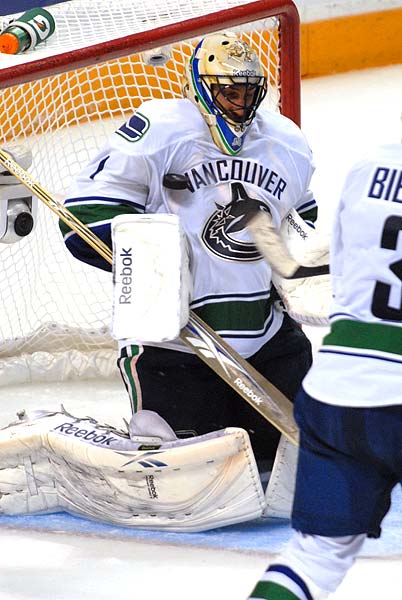
#1 ROBERTO LUONGO STOPS 1 OF 74 ATTEMPTED SHOTS (SOG/MS/BS) IN 3RD
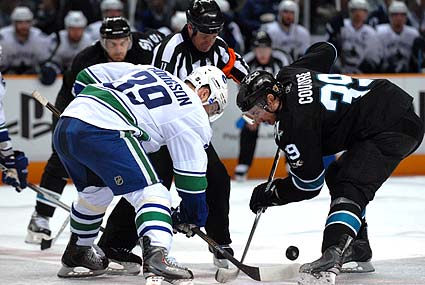
#39 LOGAN COUTURE FACEOFF VS #39 CODY HODGSON TO START 2ND PERIOD
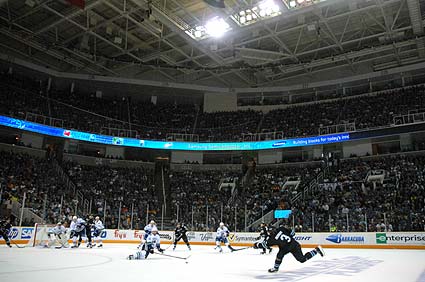
SJ DEFENSEMAN #3 DOUGLAS MURRAY WAS DANGEROUS OFFENSIVELY IN GAME 4
Notes from the Vancouver Canucks 4-2 win in game 4 of the Western Conference Finals will be posted soon. The Canucks lead the Sharks 3-1 in the best-of-7 series. A photo gallery from the game is available here.
WCF Game 4: Keith Ballard’s hit of the playoffs results in Jamie McGinn aerial cartwheel
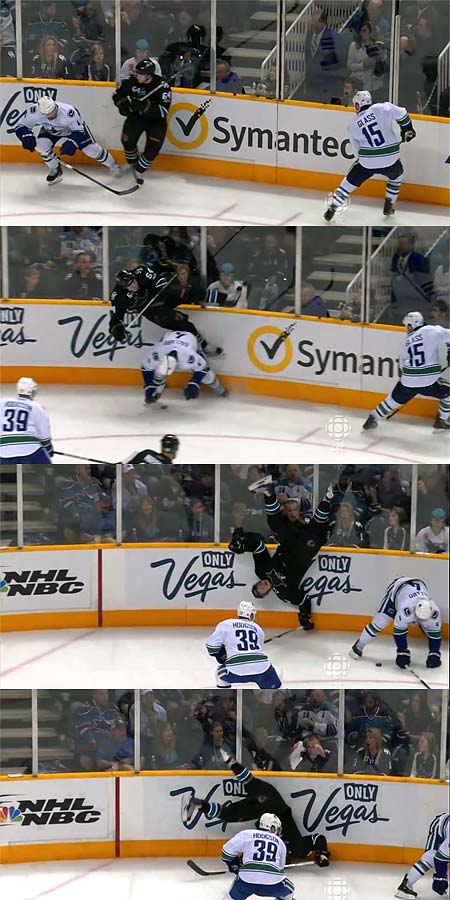
LOW HIT BY #4 KEITH BALLARD SENDS #64 JAMIE MCGINN ON AERIAL CARTWHEEL IN 2ND - CBC
San Jose Sharks forward Jamie McGinn continued his one man human highlight reel in game 4 of the Western Conference Finals, this time on the opposite end of the physical play. After knocking Vancouver defenseman Christian Ehrhoff and Aaaron Rome out of the lineup with checks in game 3, McGinn joined Andrew Desjardins and Jamal Mayers for a gritty shift after the end of the Sharks 5th unsuccessful power play in the second period. Desjardins lined up defensive replacement Chris Tanev along the end boards, then Jamie McGinn beat Tanner Glass to pressure Keith Ballard on the forecheck. Unlike Rome a game earlier, a heads up Ballard saw McGinn coming with a head of steam and dove down low to take out his legs. The collision resulted in a clean aerial 360 by McGinn, who narrowly avoided landing on his head.
McGinn hopped right back on his feet and returned to the play. With the Canucks standing on their bench, a Mayers backcheck created a turnover in the neutral zone and McGinn took a second hit by Ballard along the wall to get the puck deep. Jamal Mayers beat two players to the dump in, and dropped a back pass to McGinn. The young 22-year old narrowly slid a long backhand shot just wide of the net. The fourth line for San Jose was expected to play a minor contributing role in this series in favor of the three scoring lines, but for the second straight game they made a significant impact. It is one of the few positives the Sharks can point to after a disheartening 4-2 loss, and a 3-to-1 deficit in the series.
In a game with alternating parades to the penalty box, it is ironic that the clearest call of the night was not made. Referees Kelly Sutherland and Eric Furlatt were tight on Vancouver in the first period, and even the hard Torres check on Douglas Murray that sent him to the ice was within the bounds of the law. Keith Ballard’s hit on Jamie McGinn was not. Rule 44.1 in the NHL rulebook states “Clipping is the act of throwing the body, from any direction, across or below the knees of an opponent.” In Bryan Marchment-esque fashion (Marchment remains a development coach in the Sharks organization), Ballard dropped his entire body below the knees of McGinn to send him flying. “A player may not lower his body position to deliver a check to an opponent’s knees,” the rulebook states.
What was and was not legal was a clear mystery to the players on the ice, but according to San Jose Sharks head coach Todd McLellan arguing the officiating on three subsequent 5-on-3’s was a moot point. “It’s hard to argue the too many men on the ice penalty. It’s hard to argue the shooting the puck out of the play,” McLellan said. “I can’t sit here and whine and bitch about the officiating, because it had absolutely nothing to do with it. It was the team in the white that created that mess.” The Vancouver Canucks scored an NHL playoff record three 5-on-3 power play goals in a 1:55 span. It was a sequence that determined the outcome of game 4, and could quite possibly determine the outcome of the series if the Sharks can not find a way to maintain playoff composure and discipline moving forward.
Jamie McGinn offered his thoughts via twitter on whether or not the Sharks can get back in the series. “I believe, we can get this done,” McGinn said.
[Update] Video: Keith Ballard’s hip check ranks as the hit of the 2011 playoffs – NBC’s Pro Hockey Talk.
WCF Game 3: Vancouver Canucks lose composure with 11 penalties in game 3, San Jose holds serve with 4-3 win on home ice
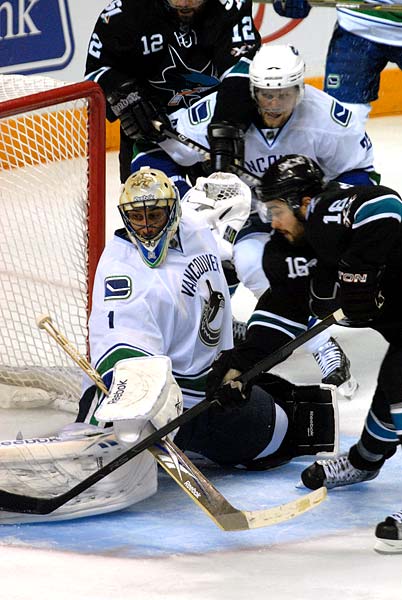
#16 DEVIN SETOGUCHI TRIES TO GATHER REBOUND IN FRONT OF #1 ROBERTO LUONGO IN 3RD
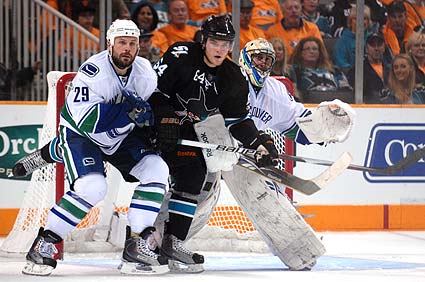
#64 JAMIE MCGINN BATTLES #29 AARON ROME IN FRONT OF VANCOUVER NET IN 2ND
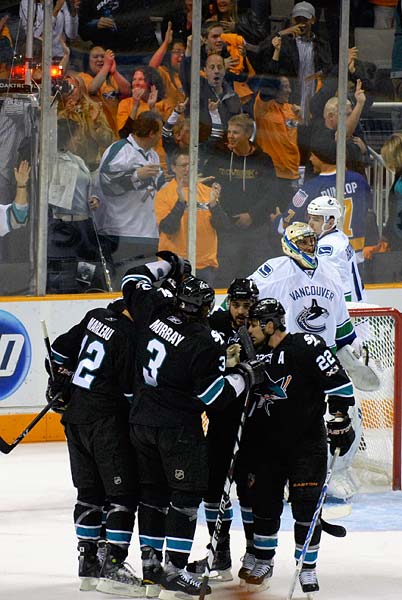
#12 PATRICK MARLEAU SCORED 4TH GOAL OF SERIES IN FIRST PERIOD
The Sharks breathed much needed life into their Western Conference Final playoff hopes holding on late for a 4-3 win over Vancouver. The Canucks lost their composure and took a string of ill-advised penalties in all three periods. Patrick Marleau and Ryane Clowe scored while on the man advantage in the first period, completing a streak of 5 straight power play goals in their first 5 opportunities against Vancouver in this series. Marleau added his second goal of the game capitalizing on a blocked Edler shot and a breakaway, and Dan Boyle added another power play goal in the third to earn the critical momentum building victory.
The vaunted Canucks defense was seldom tested in the first two games. While San Jose got the puck dep and ground down Los Angeles and Detroit blue liners, the Canucks defenseman were able to reach loose pucks and move play up ice almost at will. From the first shift of game 3 it was evident there was a sea change on the ice. San Jose’s second line of Clowe-Couture-Heatley got the puck deep in the offensive zone and created much sustained pressure.
A high hit by agitator Maxim Lapierre on Ian White 200 feet from his own goal took the Sedins off the ice and put the Sharks power play on the attack. The Canucks allowed Joe Thornton to set up behind the net, and he proceeded to pick them apart. In a battle in front, Marleau gained inside position on former Sharks defenseman Christian Ehrhoff, then allowed Ehrhoff to release and approach Thornton. Vancouver didn’t attempt to move Marleau or Setoguchi out from in front of the net, and a hard Thornton pass was banged home by Marleau. After earning the series clincher against Detroit, it was Marleau’s fourth straight game with a goal.
Less than three minutes later the Sedin’s came off and the penalty kill unit went back on the ice. This time defenseman Chrisitan Ehrhoff accidentally got his stick up on Torrey Mitchell, drawing blood and a 4 minute high sticking double minor. After a quality scoring chance down low by the first power play unit, San Jose’s second unit came out and put on a Sedin-like passing clinic with the man advantage. A series of 4 quick passes were initiated with a Dany Heatley backhanded flip to the center of the ice. Couture immediately moved the puck back to Ian White on the point, and White quickly moved a d-to-d pass at the top to Boyle. With penalty killers still working to get into position, Boyle tee’d up a hard slapshot that Luongo struggled to control down low. An unchecked Ryane Clowe on the doorstep backhanded the puck under Luongo’s pads.
The shifts after a goal or a power play goal can gauge the momentum of a period. San Jose Sharks head coach Todd McLellan discussed possible changes to his lines, or a “revamping” his top three scoring lines had they struggled early in game 3. That did not happen. What he did change up was inserting young forwards Jamie McGinn and Andrew Desjardins on the 4th line to play with Jamal Mayers. While the top 3 lines had a lot of time down the stretch to get in a rythmn and develop chemistry, the fourth line was an odd jumble neccessitated by Scott Nichol’s 20-game injury absence late in the season. McGinn was targeted as a speedy third liner with offensive instincts, but with only 1 goal and 5 assists in 49 games played, McGinn lost his regular place in the lineup after the mid-season additions of Ben Eager and Kyle Wellwood. Andrew Desjardins, an agitating member of the ‘Crazed Rats’ line in AHL-affiliate Worcester, was a late season replacement for Scott Nichol. An effective forward whose first NHL goal and assist were highlight-reel worthy, Desjardins did not see playoff starts in the first two rounds in favor of other veteran contributors.
While the fourth line could be expected to add a quality 5-10 minutes, play the body and take some of the pressure off the top lines, Friday they played a critical role in all three zones. After 240-pound defenseman Douglas Murray steamrolled a Canuck to keep the puck in, McGinn-Desjardins-Mayers began to grind down Vancouver down low. On their next shift with Setoguchi still on the ice, Desjardins and McGinn again got the puck deep and fought to keep possession of it. Asked what he wanted to show in his first playoff start, Desjardins told Sharkspage he wanted to create energy and play smart. “Try to create energy, and create offense off the energy. Try to finish your checks, try to control the puck, not get scored on, and just to be a smart player,” Desjardins said. “Basically when you have the puck down low, just hold on to it.” An awkward McGinn hit on Christian Ehrhoff in the first period apparently injured the defenseman’s left shoulder. He did not return to the game.
After Patrick Marleau blocked a point shot by Alexander Edler and scored on the resulting breakaway, the physical play picked up for both teams. Ryan Kesler left his feet trying to hit Logan Couture behind the end boards. Then he lined Couture up for a hit along the halfwall and delivered a punch to the head after the play. Kesler delivered a similar punch to Couture after a hit in game 2, neither were called. At the start of the second period, the fourth line again was making an impact down low. This time it was Desjardins and Mayers creating a sustained forecheck. After defenseman Niclas Wallin fired a shot on goal, Desjardins was taken down hard by a pair of Canucks in front of the net. After an offensive zone faceoff win McGinn was taken down in front of the net when Aaron Rome got a stick between his legs. It was the first successful penalty kill by Vancouver against San Jose in the 2011 playoffs, but again the impact of the 4th line was being felt.
It was a fourth line that had changed throughout this series. Ben Eager and Scott Nichol were members of the fourth line switched out after game 2, and Benn Ferriero was a fourth liner switched out after game 1. When speaking of depth and the San Jose Sharks, it is a depth across the board. From the top three scoring lines, to a group of about 8 forwards who may be utilized and may make an impact on the fourth line, to the defensive corps and defensive replacements Kent Huskins and puck moving rookie Justin Braun. Even in net, Antero Niittymaki is a proven veteran replacement and emergency goaltender Thomas Greiss should have been playing in the NHL instead of Europe this season. The Sharks are prepped well for the war of attrition, as well as the playoff war against the Canucks.
Game notes keep pointing to McGinn. Later in the period, defenseman Kevin Bieksa misplayed a pass back to the point. His defensive partner Dan Hamhuis lined up Jamal Mayers for a big hit as Douglas Murray poked the puck up ice. McGinn blew by Bieksa and created a 2-on-0 with Desjardins. They forced Bieksa to take a hooking penalty and face the mob of neoprene teal and orange fans adjacent to the penalty box. Bieksa took a second penalty later in the period. The Sharks could have pressed that furthur, but they got into penalty trouble of their own at the end of the second.
Desjardins took a holding the stick call at 14:27, before Joe Thornton took a holding the stick call of his own at 15:01. The Canucks would have a 5-on-3 for 1:26, a golden opportunity to get back into the game. Instead, Niemi made a point blank save on Burrows, and point shots by Sami Salo were blocked by Murray and another missed the net wildly. Salo registered 1 shot on goal in 24:30 of ice time. 2 missed the net, and apparently 6 were blocked. After Murray’s block on Salo down 2 men, Pavelski blocked a Salo shot of his own. After the play was frozen, Murray and Pavelski fist bumped for a mini-pk celebration.
After the Sharks killed off the bulk of the 5-on-3 and got the puck deep, Ryan Kesler broke it out of his own zone along the left wing. As he exited the box, Desjardins hooked Kesler and he was directed right back in to the bin with a tripping call. It was a legitimate penalty, but Kesler embellished the call kicking his legs back on the play and looked like he was diving head first into a pool. It was not the only embellishment of the net, as several Canucks did half rolls or eyes looking up at the ceiling maneuvers after incidental contact. Referees Brad Watson and Dan O’Rourke called both teams heavily, but any way it shook out there were going to be 2 unhappy teams. As Desjardins headed back to his seat in the penalty box, Joe Thornton gave him a fist bump, acknowledging his effect on the first half of the game while still trying to settle down and keep him from becoming too emotional.
Asked how he wanted to approach his first playoff game after a penalties dominated the Sharks loss in game 2, Desjardins said it would be a team effort towards discipline. “I think that is an overall thing after the last game,” Desjardins said. “We have to try to keep disciplined and try to work towards that.”
This time Vancouver would have a 30 second 5-on-3 powerplay. Given the Sedin’s ability to slice and dice NHL penalty kills, it was a turning point in the game. Each clear in the first 5-on-3 resulted in a loud roar from the sellout crowd in HP Pavilion. On the second 5-on-3, Vlasic ate up nearly 15 seconds taking out his man and laying on top of the puck. The crowd erupted after a clutch Niemi save as both penalties wound off the clock.
In tennis, a flat well-placed serve can create aces. Free points. There would be no free points in game 3 for San Jose. Kevin Bieksa turned the corner in the Sharks zone, and shoveled the puck in front of the net. Alexander Burrows jumped into the play and buried it. 3-1. On a later shift, Ryane Clowe tried to line up Bieksa for a hit along the end boards. Bieksa jumped out of the way to his left, but Clowe ran smack into the head of a curling Logan Couture. Couture left the game and underwent the concussion protocols mandated by the league, but he noted that he did not suffer a concussion.
At times in each period the Vancouver Canucks lost their composure and took bad penalties. It was Alexander Burrows’s turn in the third period. Less than a minute after Ryan Kessler took a tripping call, Burrows leg whipped Antti Niemi as he tried to pressure the Sharks on the forecheck. The Sharks would convert their third power play of the game. After Dan Boyle rang a shot off the post, the next sequence saw a give-and-go between Marleau and Boyle at the point. With Heatley creating a screen in front, Boyle fired a shot that beat Luongo 5-hole. Luongo laid back in the net in frustration after the goal.
The Sharks have not done anything easy in the 2011 playoffs. Whether it was a comeback from a 4-0 deficit and three overtime wins against Los Angeles in the first round, or giving up a 3-games-to-0 lead and winning a game 7 against Detroit in the second round. Game 3 against Vancouver would be no different. Up 4-to-1, the Sharks would have to kill off a 5 minute major penalty on Jamie McGinn in the final 8 and a half minutes of play.
Alexander Burrows broke into the Sharks zone, but was forced wide by Torrey Mitchell. Mitchell got his stick out, resulting in a low percentage shot easily stopped by Niemi. Defenseman Kent Huskins moved the puck from behind the net up the wall and it was again misplayed by Bieksa. This time Bieksa went off for a line change allowing Roberto Luongo to play it in his own zone. As Luongo had his back to the ice, Jamie McGinn took several hard strides across the offensive zone anticipating where Luongo would play the puck. Luongo did not look over his should once, instead he telegraphed his pass to defenseman Aaron Rome effectively hanging him out to dry. Rome himself did not have his head on a swivel. He did not see how quickly McGinn was bearing down on him, and he was hammered up against the plexiglass in the corner. Rome was motionless on the ice for several minutes, and he had to be helped to the locker room.
After killing off a pair of 5-on-3’s against the Vancouver power play in the second period, the Sharks would have to kill off a 5 minute major at the end of the third. The Canucks looked lethargic early. Jamal Mayers blocked a shot in front, and Douglas Murray had his helmet ripped off his head by Kesler after the Canucks alternate captain was hit along the boards. Henrik Sedin was finally able to create on the power play, holding on to possession long enough for Dan Hamuis to get into an open spot and bury a 1-timer. 4-2 Sharks. The Sharks were able to kill off the first 2:16 without as much urgency from Vancouver, and it was a similar story for the next 2:25. All it takes is a faceoff win or a good bounce to create offense, and Vancouver received both as the 5 minute major was winding down. Mason Raymond won a clear offensive zone draw back to Bieksa, and a Bieksa point shot deflected off the foot of Ian White and by Antti Niemi. On the PK, defenseman are taught to have their feet perpendicular to the net to prevent such deflections. Although White’s foot was in the right place, the shot had enough heft on it to travel for the most part on it’s original course.
Despite a furious Vancouver comeback attempt late, the Sharks were able to collapse down low and ride out the 4-3 win. Ryane Clowe narrowly missed an empty net goal on a diving block by Alexander Edler. To continue the tennis metaphor, each team has held serve on home ice to this point. San Jose will have to continue to outwork Vancouver and mainting discipline for that to take place in game 4.
A photo gallery from the game is available here.







 Editor: Jon Swenson
Editor: Jon Swenson Writer: Max Giese
Writer: Max Giese Writer: Darryl Hunt
Writer: Darryl Hunt